
The Project Gutenberg EBook of Leadwork, by W. R. Lethaby
This eBook is for the use of anyone anywhere at no cost and with
almost no restrictions whatsoever. You may copy it, give it away or
re-use it under the terms of the Project Gutenberg License included
with this eBook or online at www.gutenberg.org
Title: Leadwork
Old and Ornamental and for the most part English
Author: W. R. Lethaby
Release Date: January 5, 2013 [EBook #41544]
Language: English
Character set encoding: UTF-8
*** START OF THIS PROJECT GUTENBERG EBOOK LEADWORK ***
Produced by Chris Curnow, Rosanna Murphy and the Online
Distributed Proofreading Team at http://www.pgdp.net (This
file was produced from images generously made available
by The Internet Archive)
Transcriber’s Notes:
Punctuation has been standardised. Spelling has been retained as it appears in the original publication except as marked like this in the text. The original text appears when hovering the cursor over the marked text. A list of amendments is at the end of the text.
The text contains a few greek phrases, marked like this. The transliterated text appears when hovering the cursor over the marked text.
The cover image was created by the transcriber and is placed in the public domain.
[i]
[ii]
[iii]

[iv]
[v]
| SECT. | PAGE | |
| I. | Of Material and Craftsmanship | 1 |
| II. | An Historical Sketch | 5 |
| III. | Of Lead Coverings to Buildings | 17 |
| IV. | Of Leaded Spires and Turrets | 20 |
| V. | Of Domes | 33 |
| VI. | Of Roofs | 36 |
| VII. | Of Lead Coffins | 40 |
| VIII. | Of Fonts | 51 |
| IX. | Of Inscriptions, Etc. | 65 |
| X. | Of the Decoration of Lead | 72 |
| XI. | Of Lead Ornamentation of other Materials | 80 |
| XII. | Of Decorative Objects | 84 |
| XIII. | Of Lead Glazing | 87 |
| XIV. | Of Lead Statues | 90 |
| XV. | Of Lead Fountains | 112 |
| XVI. | Of Vases and Gate Piers | 114 |
| XVII. | Of Finials and Crestings | 124 |
| XVIII. | Of Cisterns, etc. | 131 |
| XIX. | Of Gutters | 137 |
| XX. | Of Pipes and Pipe Heads | 139 |
[vi]
[1]
To none of the processes of modern mechanism do more vulgar associations cling than to “Plumbing.” It is the very serviceableness and ductility of lead as a material that have brought about the easy and familiar contempt with which it is treated. While few are more worthy of artistic care no metal is more perfectly adaptable to noble use through a range of treatments that cannot be matched by any other metal whatsoever. It combines extreme ease of manipulation with practically endless durability, and a suitability to any scale, from a tiny inkwell, or a medal, to the statue of horse and rider, a Versailles fountain, or the greatest cathedral spire.
The range of method in handling follows from the equal ease with which it can be[2] hammered out, cast, or cut, and all three, employed concurrently on the same piece.
The main purpose of the pages which follow is not to set out a history of the use of this material in various forms, although this is involved. It is intended by pointing out the characteristics and methods of the art of lead working in the past to show its possibilities for us, and for the future. A picture of what has been done is the best means of coming to a view of what may again be done. But it cannot be too strongly asserted that the forms of past art cannot be copied; that certain things have been done is evidence enough to show that we cannot do them over again. Reproduction is impossible; to attempt it is but to make a poor diagram at the best.
Commercially produced imitations of ornamental works are infinitely beneath the merely utilitarian object which serves its purpose and attempts nothing more. Behind all design there must be a personality expressing himself; but certain principles of treatment and methods of working may be understood in some degree by a study of past work without going all through it again. History thus makes the experience of the past available to us, but it does not relieve us of the necessity of ourselves having experiences. There is a great stimulus in feeling one of a chain, and entering into the traditions of a body of art. The workman Bezin said to Mr.[3] Stevenson of museums, “One sees in them little miracles of workmanship—it fires a spark.”
New design must ever be founded on a strict consideration of the exact purpose to be fulfilled by the proposed object, of how it will serve its purpose best, and show perfect suitability to the end in view when made in this or that material by easy means. This, not the torturing of a material into forms which have not before been used, is the true ground of beauty, and this to a certain extent is enough without any ornamentation. Ornament is quite another matter, it has no justification in service, it can only justify itself by being beautiful.
In so far as history is involved here it has been necessary to refer to and to figure many works, not bearing the impress of a fine living style, but only passable exercises in the respectabilities of a sort of conventional design learnt by rote. As a general rule it will be found that the workers of the middle ages penetrated at once to the reason of a thing in structure and then decorated it with an evidence of fresh thought—a delight in growth, form, humanity, in one word Nature, the source of all beauty and subject of all art. Each thing made is evidently by an artist; it expresses reasonable workmanship and happy thought in pleasant solution of some necessity of actual service. Many of the later things are not thus natural and spontaneous but pedantic and pompous, fulfilling their chief intention if[4] they were expensive; while to-day the chief care of design is often to appear expensive without being so in fact.
Only in our century in England would it be possible for the metals which are so especially hers, iron, tin, and lead, to have been so degraded that it is hardly possible to think of them as vehicles of art. It should not be so, for each of the metals can give us characteristics that others cannot, and the capabilities of lead have been sufficiently proved by more than two thousand years of artistic manipulation.
The only way in which the crafts can again be made harmonious by beauty is for men with a sense of architectural fitness and a feeling for design to take up the actual workmanship and practise it themselves as they would painting or sculpture, seeking the delight of being good artists not the reputation of being successful merchants or clever professional men. To any such, lead-working may be recommended.
[5]
The ease with which lead ores may be gained from the earth and then worked, is sufficient to show that the application of lead to the service of the arts must have been made very early.
Nowhere does it seem to have been so easily found as “in England herself which is the classic land of lead and tin” (Abbé Cochet). These two metals made the early fame of Britain; they brought here the Phœnician trader and had doubtless much to do with the Roman occupation of this distant island.
“Tin and lead,” says Harrison in his Description of England, “metals which Strabo noteth in his time to be carried into Marseilles from hence, as Diodorus also confirmeth, are very plentiful with us, the one in Cornwall, Devonshire, and elsewhere in the north, the other in Derbyshire, Weredale, and sundry places of this island.... There were mines of lead sometimes also in Wales which endured so long till the people had consumed all their wood by melting of the same.”
[6]
Tin, which was of such sovereign necessity for the composition of bronze, was, with lead, an object of wide commerce, as we may learn from the prophecy of Ezekiel against Tyre, whose long black ships did the carrying trade of the world. As the Tarshish of Scripture is the Tartessus of classic authors—an entrepôt of Phœnician trade in Spain—it may well be of English mined metal that the prophet speaks:—“Tarshish was thy merchant by reason of the multitude of all kinds of riches; with silver, iron, tin, and lead they traded in thy fairs.”
The Assyrian slabs which contain the accounts of the expedition into Syria in the ninth century B.C. include among the tribute exacted of Tyre and of Jerusalem itself “bars of gold, silver, copper, and lead.” Solomon used lead in the structure of the great wall of Jerusalem.
Sir H. Layard says the mountains three or four days’ journey from Nineveh furnished iron, copper, lead, and silver in abundance, and he found instances of its actual use at Nineveh. Place also, in his excavations at Khorsabad, discovered a foundation inscription of Sargon II., the great builder of the eighth century B.C. engraved on a plate of lead. A leaden jar and a piece of pipe were found by Loftus at Mugheir.
In Egypt it was sparingly used. Sir G. Wilkinson says:—“Lead was comparatively[7] useless, but was sometimes used for inlaying temple doors, coffers and furniture, small statuettes of the gods were occasionally made in this metal, especially those of Osiris and Anubis.”
In Egypt as well as in Babylonia it was the custom to make a deposit of several objects in the foundations, a tradition which we still follow to-day. At Daphnae Mr. Flinders Petrie found a set of little slabs of different stones and small plates of metal, gold, silver, copper, and lead, all engraved with the name of Psamtik. The lead tablet is here figured.
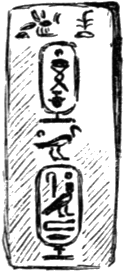
Fig. 1.
The ornamental objects of lead to which the earliest date can be assigned are those found by Dr. Schliemann in his excavations at Mycenæ and Tiryns.[1]
The Greeks very largely used lead for many purposes. It is twice mentioned in the Iliad, and its familiar use as a building material is shown by Herodotus, who says that Queen Nitocris built a bridge over the river at Babylon, of stone bound together with lead and iron; and the story the Greek historian gives of the celebrated hanging gardens describes how they were raised on high terraces of arches covered with bitumen and sheets of lead.
Sufficient actual examples of Greek lead work[8] are stored up in museums, masonry with dowels of lead, inscribed tablets, small toys and tokens, little vases for eye salve about as large as a thimble, boxes for unguents, and sling bullets. These last are often inscribed so that the warrior might know his work, often with flouts and jibes and jeers. One in the Lewes Museum has ΕΥΓΕΙ,—“Well done”; others have “Hit Hard,” &c.
In the museums of Athens are some small figures, a Dionysiac wreath of gilt lead leaves to be worn as a garland, a lead quiver for arrows about fifteen inches long, also plummets and market weights, with other objects. Mr. Cockerell found that parts of the early pediment sculptures at Ægina were of lead, and lead is inlaid in the volute of the early Ionic capital from the archaic temple of Ephesus now in the British Museum.

Fig. 2.
The plummets are interesting to us as builders’ implements; there are two or three dozen in the British Museum, about three inches high and one inch at the base tapering upwards: some are marked with the letter A on one side and on the obverse a little relief, a throne-seat with an owl. The[9] owl was Athene’s own symbol, and appears on the coinage of Athens in a form from which this seems copied. The Acropolis was her throne. We will stretch our imaginations far enough to believe that the A stands for Athens and that these are the very implements used in setting the masonry of one of the corner stones of the world’s art—the Parthenon.
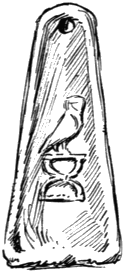
Fig. 3.
The market weights are remarkable in bearing devices like the types of coins. For the most part they are square cakes and the devices simple almost to rudeness, yet they have that impress of style and grace in the design, with the large free handling in which is the exquisiteness of Greek art. A sketchiness so simple and easy can be the only right treatment for a metal so likely to receive injury in the use; to these as in all art so considered the inevitable injuries of wear are little loss. We can hardly suppose that such a simple industry as making lead weights for the markets would have had artists capable of designing, and suggesting in relief types like these, rather we may suppose that some of the great coiners furnished the models, especially as they would be issued by the authorities of the several towns.
[10]
We may take this first opportunity of remarking that the patterns for all ornament intended for casting should be modelled like these, never carved, as is now so universally the case for cast iron and the applied enrichments of picture frames, the reason being that cast material of this sort, so easily injured, is unsuited for giving definition and high relief, and should accept all the limitations of material frankly and make the most of dull suggestiveness; for in all these the “best are but shadows” the modelling emerging from or melting away in the ground. In two attempts the present writer has made in modelling for lead casting wax was used in one instance, and in the other, where very delicate relief was required made up mostly of threads and dots, gesso was found to answer.
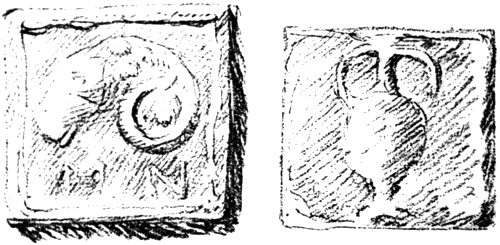
Figs. 4 and 5.—Greek Weights.
The ram’s head (see Fig. 4) for instance has[11] only the frontal, the lips, and the horn, made out, the rest the imagination sees transparently below the field. In the words of Blake “it is everything and nothing.” The raised rim is a good protection.
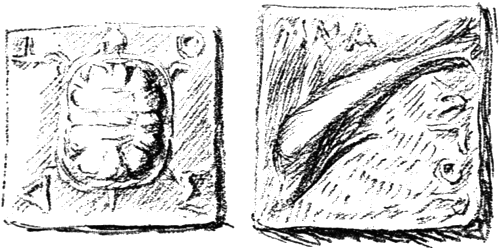
Figs. 6 and 7.—Greek Weights.
The second, a half Mina of Ægina, is yet simpler—just a pot, but a beautiful one well placed. The third is Attic, a quarter Dimnoun with scarabeus-like tortoise. The last is a Mina of Ægina, it bears the well-known Greek rendering of the Dolphin and the letters Μ Ν Α Α Γ Ο Ρ. “Market Mina.” The dolphin has the “bowed back” Sir Thomas Browne pointed out as a “popular error” of painters, but the dolphin was to the Greek mind, rather the genius of the waving sea itself than any mere particular fish, and this is the time consecrated form, like this it swims amongst the undulating hair of the Arethusa[12] of Syracuse, the most beautiful coin in the world.
The Romans used lead extensively and much in the same way as we do—for roof coverings and water pipes, in masonry and for coffins. In Rome an immense quantity of lead piping has been found. The pipes were formed of strips of cast lead bent round a rod and then soldered. Most of the work was signed by the plumber, his name and that of the owner being impressed in the sand mould.[2]
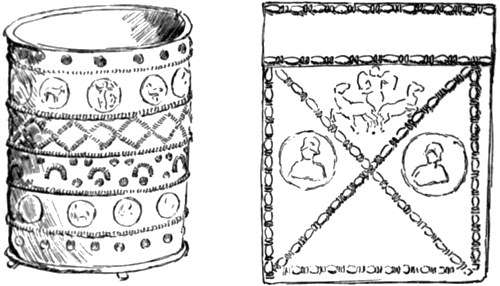
Figs. 8 and 9.—From the Kircherian Museum.
There are many beautiful cistae or circular boxes in the museums of Naples and Rome. These are decorated with little medallions, shells, beaded rods, &c., stock patterns which were impressed in the sand mould in such fresh[13] combinations as the thought of the workmen suggested, just as a cook makes pie crust, which is the subject of nearly the only spontaneous decorative art now remaining to us. Figs. 8 and 9 are from the Kircherian Museum.
Of the Roman leadwork in the British Museum the specimens are mostly coffins, and a number of ingots of lead. These “pigs” have been found in Cheshire, Staffordshire, Derbyshire, Nottingham, Norfolk, Hants, Somerset, and Sussex. Of these there are ten in the British Museum bearing names of emperors and dates which, put into our era, are—A.D. 49, Claudius; 59, Nero; 76, Vespasian; 81, Domitian; 117, Hadrian.
These pigs are about 41⁄2 by 18 inches; and even they are not without design, for some of them have the well-known classic label to receive the name.
A beautiful object, remarkable as an instance of lead used in an article of price, is a vase some 5 inches high. This is evidently a wine cup from the figures and emblems which decorate it—Bacchus, Silenus, thyrsi bound with cords, and four genii of the Seasons carrying appropriate symbols, one being a garland, another a sheaf of corn; around the middle is a belt set with glass jewels of varied colour, dull reds, greens, and blue, and below this is a wreath of vine (Fig. 10).
Compare a very richly decorated vessel in the engravings of the Museo Borbonico.
[14]
Lead water pipes of Roman make are frequently found in England; at Bath there is a water channel 1 foot 9 inches by 7 inches, of lead nearly one inch in thickness, and sheets of it 10 feet long lined the basin of the great bath, 30 lbs. in weight to the foot. In the refuse of the Mendip mines Roman lamps and other articles of lead have been found.
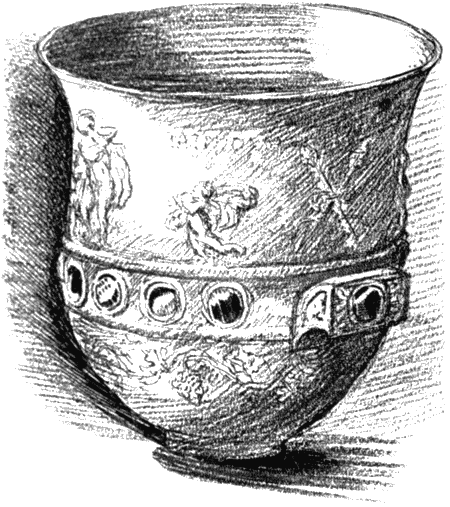
Fig. 10.—Roman Jewelled Cup.
[15]
During the Byzantine era lead was much used. In a curious relief found at Tunis “the founder seems to have used up all the old models in his studio. Here a Good Shepherd, Peacocks, and stags drinking from the four mystical rivers, palms and vines, are found side by side with Silenus, a Victory, a Nymph, an Athlete, and scenes of the chase.”[3] In Saxon England lead was a staple commodity for export and used in great quantities at home. English merchants of lead and tin are mentioned as attending the French fairs from the time of Dagobert. During the middle ages it was largely applied to many purposes and manipulated by the various methods and decorated with the ornaments, particulars of some of which follow. England was still the best esteemed source of supply. About 1680 M. Felibien wrote a book on the crafts connected with architecture, in which he says that “The greatest part of the lead we use in France comes from England in large ingots called ‘Salmons,’ a little lead also comes from Germany, but it is dry and not so sweet as the English.”
Up to the 15th century sheet lead was cast only, but a coffin of the Duke of Bedford (Joan of Arc’s) at Rouen is already laminated.
Lead is an easy medium for the forgery of antiques, and some of the objects so produced are quite pretty. In the museum at Taunton[16] there is a small lead bottle which seems to be a forgery.
The Plumbers’ Company in London appears to have been in existence early in the fourteenth century. In 1365 (39 Edward III.) ordinances were granted to the Company which had then been in existence some years. In 1588 (31 Elizabeth) arms and crest were granted; and in 1611 (9 James I.) a charter was given renewing all powers and privileges.
Throughout the middle ages lead was more extensively used in England than elsewhere—our cathedral roofs, for instance, were all of lead, whereas abroad they are often of corrugated or flat tiles, stone or slate. The methods of conducting water from the roof by stone gutters and gargoyles was much further developed in France than here, where lead always came to hand. Lead pipes with ornamental heads were first introduced here in England for this purpose, and they reached a development without parallel abroad. During the eighteenth century there was, as we shall see, a large industry in lead statues, and the plumber’s art continued to the opening of the present century; indeed, cisterns decorated with the old devices may be seen as late as 1840, and some of the old methods have not yet passed entirely out of memory. The Exhibition of 1851 marked exactly the general eclipse of craft tradition. England was no longer to be saved by work, but by commerce.
[17]
Sheeting buildings with decorative plates of metal has been one of man’s architectural instincts. M. Chipiez, in his essay on the origins of Greek architecture, considers first:—“The temple, metallic or covered with metal, which obtained in Medea, Judaea, and in Asia Minor. Greek writers like Pausanias speak of edifices having been constructed of brass; such was the legendary temple of Apollo at Delphi, that of Athena Calkhioecos in Sparta, and the treasury of Myron, tyrant of Sicyon. In the Eneid the temple erected at Carthage by the Phœnician Dido is also of brass.” From Homer to the Arabian Nights and the mediæval romance writers, a metal-cased architecture, shining with gold, has been preeminently the architecture of the poets.
It would almost seem as if in the Merovingian age Western Europe passed through the phase of a metal-cased architecture, but in this case it was lead that formed the external vestment—an[18] architecture of lead. “Under the Merovingian kings,” says M. Viollet-le-Duc, “they covered entire edifices, churches, or palaces, in lead. St. Eloi is said to have so covered the church of St. Paul des Champs with sheets of lead artistically wrought.”
In England Bede mentions a parallel instance. Finian the successor of St. Aidan in the See of Lindisfarne built a church after the manner of the Scots of hewn oak with a thatched roof; afterwards “Eadbert also bishop of that place (638) took off the thatch and covered it both roof and walls with lead.”
The exaggerated lead roofs of the early mediæval churches in England were in nowise dictated by utilitarian considerations. The creeping of the lead on steep surfaces, the many burnings, and the great expense in large churches which would take literally acres of lead, made maintenance a burden, but they liked this metal casing, and that was enough.
This is still more evident in the mediæval delight in the tall leaded spires, not in their aspect as mere roof coverings, but intrinsically as metal shrines, looking on them with their decorations as vast pieces of goldsmith’s tabernacle work. The steep pitch of the roof of the main building when applied to a square tower quite naturally produced leaded spires. These already appear in the drawing made of Canterbury Cathedral about the year 1160.[19] That these metal-sheeted spires were the best loved form, and that stone was adopted at last but as a truce with fire is proved by the spires of lead which appear in the wall paintings (those that were at St. Stephen’s for instance), in the MSS., and by the splendid leaded spire of St. Paul’s which we shall speak of below. The spire so treated is not a mere roof, or a cheap substitute for stone, but takes its place in metal-cased architecture, as do also the leaded Byzantine domes of St. Sophia and St. Mark’s.
In that most splendid work of the English renaissance, the palace of Nonsuch, which was begun by Henry VIII. in 1538, the structure was what we call half-timber, the panels were filled with coloured and gilt reliefs by Italian modellers, and the timber framing is described by Pepys, who visited it in 1665, as sheeted with lead. This casing we may be sure was covered with delicate Italian arabesques. His words are, “One great thing is that most of the house is covered, I mean the posts and quarters in the walls, with lead and gilded.”
[20]
Our own old St. Paul’s, the once highest steeple in the world, which rose 500 feet and more into the clouds, from whence it at last drew the lightning to its destruction, was the proudest example of these lead spires which for beauty at least equalled the finest examples in stone. When the second church, begun at the end of the eleventh century, was but just completed; “the quire was not thought beautiful enough, though in uniformity of building it suited with the church: so that resolving to make it better they began with the steeple, which was finished in A.D. 1221.” This was the lead-covered steeple, the only spire of the church which stood centrally over the crossing. It was 1312 before the modification of the old church was done, and thenceforth that part was known as the “new work.” Within three years afterwards a great part of the spire of timber covered with lead being weak and in danger of falling was taken down and a new cross, with pommel large[21] enough to contain ten bushels of corn, well gilt was set on the top thereof by Gilbert de Segrave the Bishop of London with great and solemn procession, and relics of saints were placed in it.[4] The relics of saints were thus put at the apex as a safeguard from lightning.
This lead spire, repaired in 1315, must have been the work spoken of as finished in 1221, and it was thus the earliest lead spire of considerable dimensions of which we have any knowledge: it was an extraordinary development from the square lead pyramids that covered the Norman towers at Canterbury and other places.
Stow says the height was 520 feet “whereof the stone-work is 260 feet, and the spire was likewise 260 feet. The cross was 15 feet high by 6 feet over the arms, the inner body was of oak, the next cover was of lead, and the uttermost was of copper red varnished. The bowl and the eagle or cock were of copper and gilt also.” The ball at the apex was three feet across and the weathercock four feet from bill to tail and three feet six inches across the wings. “Certes,” says Harrison, “the toppe of this spire where the weathercocke stode was 520 foote from the ground of which the spire was one half.” The measurements of Wren confirm the height of the stone tower (which alone was standing in his day) as being 260 feet, the spire, he says, had been 40 feet[22] diameter at the base and rose 200 feet or more. It must have been altogether worthy of this vast church of twenty-five compartments in the interior vista of arch and vault, 600 feet in greatest length and 100 feet high. In 1444 the spire narrowly escaped destruction by lightning, but the fire was put out. “In the year 1561, the 4th of June, between the hours of three and four of the clock in the afternoon, the great spire of the steeple of St. Paul’s Church was fired by lightning, which brake forth as it seemed two or three yards beneath the foot of the cross: and from thence it went downwards the spire to the battlements, stonework, and bells, so furiously that within the space of four hours the same steeple with all the roofs of the church were consumed to the great sorrow and perpetual remembrance of the beholders.”[5] It was thus destroyed a hundred years before the great fire when the cathedral perished.
London was a city of lead spires. Stow tells us that at St. Paul’s School close by the Cathedral was “of old time a great and high clochiard or bell-house, four square built of stone and in the same a most strong frame of timber with four bells the greatest that I have ever heard. The same has a great spire covered with lead with the image of St. Paul on the top.” It was said that Sir Thomas Partridge won it by a throw of dice from Henry VIII., and pulled it down.[23] Stow, who would have thought the Society for the Preservation of Ancient Buildings, to which we owe so much good work, much too cautious in its methods, reports with much pleasure, “This man was afterwards hanged on Tower Hill.” At St. Bartholomew’s Priory, Smithfield, was another of these timber spires.
A spire said to have been even higher than this of St. Paul’s was erected in the fourteenth century over the central tower at Lincoln. The two western towers also had spires which were taken down to save the cost of repair within this century. This group of three great leaded spires crowning the Hill-city must have been one of the most wonderful the whole world over. The central tower as it now stands is 270 feet high 54 feet on the face; it was finished in 1311. “The spire of timber covered with lead reaching a height of 524 feet which once surmounted it was destroyed by a tempest in 1548.”[6]
The plates in Dugdale’s Monasticon engraved by Hollar and others surprise us by the number of leaded spires to the cathedrals not one of which has survived storm and flames or the crueller hatred of beauty which the modern mind has developed. There are those of the two west towers of Durham, western spires at Canterbury, Peterborough, and Ely, all three at Lincoln, and four smaller pinnacles at Norwich. Two square pyramids shown to the west tower[24] of Southwell, were probably the original covering of the twelfth century. These are now “restored” and they look as false as the word.
The great central spires at Rochester and at Hereford and the central and two western spires at Ripon are shown of lead, as is also that of the beautiful isolated belfry at Salisbury, which was destroyed “to improve the view of the cathedral.” Of three of these large central spires shown in Dugdale, Rochester and Hereford rise from square towers with “broaches”: the first is of a curious and yet happy form, with recessed faces, and the other is an octagon of which the cardinal faces are wider than the alternate sides. The great spire of Ripon rose within the stone parapet of the tower, apparently at first twelve-sided with gables, and the spire itself twenty-four, each pair making a slight reentering angle—a beautiful composition it must have been of light and delicate shadow on the silver white of the old lead. This fair colour is of great importance; several of the old spires which remain to us are as white as if whitewashed. Modern ones, like the grimy thing at Lynn, would be improved by being whitewashed. The old, that at Minster in Kent for instance, tell as bright high lights in a general view of the landscape such as that you obtain from Richborough.
The finest of the English spires now existing constructed of timber and sheeted with lead is that of Long Sutton in Lincolnshire, the highest,[25] oldest, and most perfect. The stone tower with octagon projections at the angles, is 25 feet square and 65 high, standing free from the church to which it is attached by one angle only. The flèche itself is 85 feet from the eaves to the top of an enormous relic “pommel” some four feet in diameter, which is thus 150 feet in the air. The four octagonal projections carry large pinnacles 25 feet high, which at a little height disengage themselves wholly from the great flèche, but with consummate art all lean their axes inwards towards it as much as two feet. The wooden framing, carefully measured by Mr. Austin,[7] shows that this grouping of the lines was as much done from set purpose as the inclination of the lines in the Parthenon of which we hear so much. Each face of the leading has the rolls arranged in a double row of herringbone, and the faces of the pinnacles have the leading slanting in one direction only. Altogether it is a most interesting and most beautiful work of the thirteenth century.
[26]
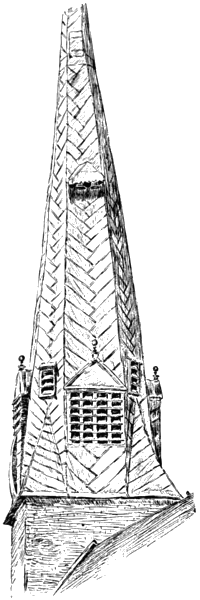
Fig. 11.—Spire, Barnstaple.
The drawing here given is of the fine old steeple at Barnstaple, which was saved from destruction by the good advice of Sir Gilbert Scott—and lack of funds! It is a delightfully careless and cheerful looking object, like that at Chesterfield, warped and nodding, which outrages the precise sensibilities of the townspeople; it was erected in 1389, as appears from the accounts[27] and was repaired and altered in the seventeenth century (as shown by a date and initials, “1636 W. T.”), at which time the spire lights were opened out. The external bells are unusual in England. There are two other spires of village churches in the neighbourhood at Braunton and Swymbridge. The spires at Chesterfield, Godalming, Almondsbury in Gloucestershire, Wrighton in Northumberland, and Harrow (1481), are among the finest that remain. Of the destroyed church at Reculver the west towers, which are retained as landmarks, had lead spires. In some spires in Norfolk, about Cromer, two or three feet of the leading is omitted, thus forming an open band through which the timbering and a bell hung here may be seen. In some of the spires the lead is laid in vertical strips, as at Minster in Thanet, and a sketch given from a church in Hertfordshire shows the lower part in a way arcaded by an ingenious arrangement of the rolls. At great Baddow Church, Essex, vertical rolls run up about two-thirds of the spire, and the rest is plain. Generally, however, the lead work is arranged in herring-bone with careful irregularity and change so as to get a texture in the[28] surface so different to the dead and dreary accuracy we should attain to. Low square spires at Ottery St. Mary are good examples of lead texture for those who see some beauty in the jointing of the armour of a tortoise.
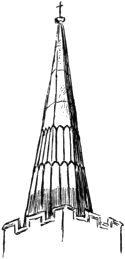
Fig. 12.
The construction of the wood framing of the greater of these spires is a forest of intricate interlacing timbers, the best authority for which is the article Flèche in Viollet-le-Duc, or Burges’ drawing of Amiens in his volume of careful studies of the Gothic art of France.
The most decorated of these lead spires in England—although not very large—is at East Harling in Norfolk. It rises within the stone battlement and has an open stage with wood pinnacles and crocketed “flying buttresses” all covered with lead. The sides of the spire proper, very narrow and acute, have the rolls arranged in lozenges instead of the usual herring-bone or vertical lines, the lozenges are on one side as wide as the face, breaking into a zig-zag above, on another side are smaller lozenges three or four in the width changing into one again above: at the apex is a large finial knob.[8]
Wren’s knowledge of the spire of old St. Paul’s possibly led him to try his hand at leaded spires, and the result in some of the City churches, particularly that one on Ludgate Hill that is such a perfect foil for the great dome of St. Paul’s, shows his usual assured mastery. The[29] spire of St. Olave, Hart Street, is said to have a crystal ball at the apex.
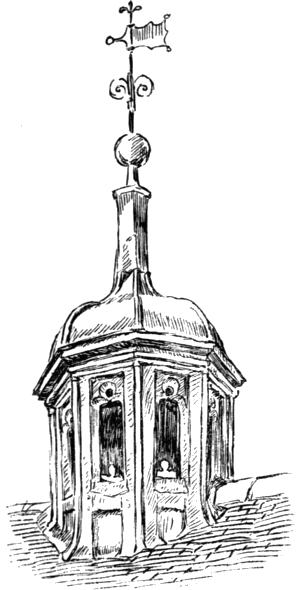
Fig. 13.—Barnard’s Inn Hall.
The smaller turrets on college halls are generally covered with lead in an ogee form. Those at Oxford have often a lozenge raised on each face, that on Barnard’s Inn in the City is wholly enveloped in lead. A turret on the alms-houses at Abingdon has large letters and crowns, which are gilt, standing up free on the slanting faces. At Hampton Court there are turret roofs, ogee with crockets and finials and little pinnacles set round at the springing. At Nonsuch leaded turrets surmounted the great octagons at the angles, they were probably much decorated and certainly of considerable size, making very picturesque compositions, as we may[30] see in the rude views of the palace which exist.
In France and Germany there are many remarkable leaded spires, but we can only stay to mention the steeple at Chalons-sur-Marne, the central flèche at Amiens, and the belfry at Calais. The steeple at Chalons is a most interesting work, large and well-designed, with faint and fascinating remains of a gorgeous scheme of colour decoration patterning the whole surface of the lead with figures and canopies resembling the drawing on stained glass, the lead rolls passing across the design like the iron glazing bars. This was carefully drawn by Burges and illustrated in the Builder for 1856, and the whole spire is represented to scale in the Sketch Book of the Architectural Association for 1883. This is a work of the end of the thirteenth century, and the decoration was done in the following century. It will be well to mention it more particularly later, but as Viollet-le-Duc says that nearly all the lead work of the middle ages was so decorated we may conclude that such a magnificent spire as St. Paul’s was not entirely bare of gold and colour.
The flèche at Amiens, which rises from the roof some 100 feet of “transparent fretwork which seems to bend to the west wind,” is well illustrated in Viollet-le-Duc’s Dictionary as well as by Burges. Every resource of the art was lavished on it, pinnacles and niches, lead statues,[31] tracery, great circular coronets of pierced cast work. The sheet lead was diapered with fleurs-de-lis, and all was decorated with designs in colour and gold. Although perfectly Gothic in form it is a work of the sixteenth century, and the painting is in the manner of the Renaissance.
At Calais the fine belfry represented in Fig. 14, which was completed about 1600, is in some respects very English in character, while on the other hand it is a northern representative of a class of bulbous spires which are as much cupolas as spires, and were probably often intended as fantastic domes. These, although later found all across Europe, from Russia to Belgium, were never naturalised in England on a large scale, our nearest approach to them being in the ogee cupolas of small turrets and lanterns and some of Wren’s spires. In Holland they were very much affected in the most extravagant forms, and they are now the constant form of church spire seen in eastern Europe. They seem much at home in such a city as Buda-Pesth, and have doubtless characteristics which endear them to those of Mongolian blood and speech. It is an interesting point to decide whether these forms are in origin actually Eastern—“travelled topes” as a friend says—or whether they are the natural outcome of a combination of spire and dome in a period of extravagant and declining taste.
[32]
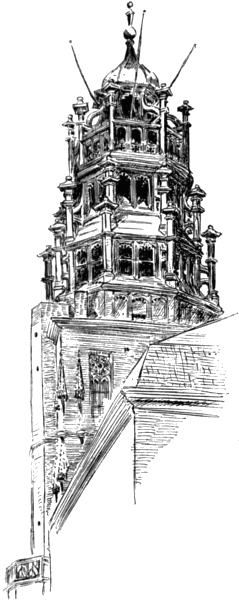
Fig. 14.—Calais Belfry.
[33]
The Romans covered domes in lead; during the Byzantine empire they very generally did so. Constantinople in the age of Justinian was a city of lead domes, as it has always since remained. The domes of St. Sophia are still covered with lead laid over the brickwork. This tradition was carried on by the Greek master builders who erected the great mosques for the conquerors. A large mosque has as many as twenty or thirty domes of all sizes grouped about the central one. The bazaars, caravansaries, and bakeries, have long level rows of cupolas. This prospect of dome beyond dome in a succession as of billows is of marvellous beauty in a general view of the city as seen from the sea. The lead is laid over the brickwork, the rolls are very small, and as they have no wood core the lines are very irregular. Some of the lead domes of Constantinople were melon-shaped, that is having large convex gores. A Turkish example of this remains in an ogee-shaped dome at the angle of the Seraglio wall near St. Sophia.
[34]
Most interesting works of this tradition are the “domes” or rather domical roofs of St. Mark’s at Venice. Those eastern-looking forms which give such fantasy to it were raised to their present form on wooden framework in the thirteenth century. They are sheeted with plain rolls except the bulb-formed lanterns, which are much like an umbrella in which every gore has a salient angle, a “ridge and valley.” These five timber-framed spire-like domes, erected for their own sake and not lying close to the interior form of the building, in this respect resemble northern spires. The whole group rising over the level front of St. Mark’s is a work of the highest imaginative genius. It is not a building with a dome but a building roofed in domes, bubbling over with domes; and it expresses the metal shrine idea in perfection. The original leaded domes of St. Mark’s were copied from those of the church of the Holy Apostles at Constantinople, a church built by Justinian.
At the Renaissance the leaded dome became a popular commonplace especially at Venice. For the most part these were covered like a roof with ordinary rolls. By forming ribs and panels in the wooden foundation a more elaborate but not more successful aspect is obtained. St. Paul’s is well designed in this way. This design with the great ribs Sir Christopher Wren considered “less gothick than sticking it full of rows of little windows” as at St. Peter’s. It was first intended[35] to cover St. Paul’s dome with copper, but £500 was saved by substituting lead at a cost of £2,500.
At the National Gallery—a very careful and refined work, one of the last of the old scholarly dead language sort we call classic—the lead covering is formed into raised scales and frets, very well and successfully done of its kind.
[36]
The Romans used lead as a roof covering. In the West “one can hardly (Viollet-le-Duc says) explore the ruins of a Gallo-Roman erection without finding some sheet-lead that had been employed for gutters or roofs.” In the East—Eusebius says of Constantine’s Basilica (the Holy Sepulchre) at Jerusalem—“the roof with its chambers was covered with lead to protect it from the winter rain.” In England Bede tells us of Wilfrid having roofed his church at York with lead in the seventh century, and it has continued without a break in its use as the most perfect of coverings.
The methods employed in the middle ages are described by Burges and Viollet-le-Duc. The latter well remarks that of lead covering, as well as many other parts of the construction of buildings, we are a little too apt to think overmuch of the perfection of our modern methods while we are too little careful to learn the experience acquired by our forefathers.
The old cast lead is much thicker than the modern milled lead, being as much as twelve or[37] thirteen pounds to the foot of surface. It is certainly not quite even in thickness, and is subject to faults in the casting, but it is not so liable to crack as is milled lead. The old lead employed has also a considerable quantity of silver and arsenic in it, which was the cause of the beautiful white oxide it obtained. Modern lead blackens as the preparation of lead now includes its “de-silverisation.” The acid of timber which has not lost its sap decomposes lead; old building timber was water-seasoned as only ship timber now is.
The chief difficulties that had to be overcome in the use of lead were the weight of the sheets of lead to be maintained in position, and the great dilatation of the metal under the heat of the sun, so that it had to be at once strongly attached and free to move. The method followed was to nail it at the top and roll the lateral edges together.
The roofing at Canterbury was of twelve-pound lead and about 2.0 between the rolls. The thirteenth century lead of Chartres Cathedral, “covered externally by time with a patina hard, brown, and wrinkled, and shining in the sun,” was in sheets eight feet long, attached at the top by nails with very large heads and held at the bottom by clips of iron that passed down between the sheets and turned over the bottom edge of the upper one. The rolls were formed by turning over the margins one in the other without a[38] wood roll; they were much smaller than the modern ones.
Our milled lead is rolled out in sheets about 16 × 6 feet and is usually cut in half lengthways, and 41⁄2 inches is allowed in each edge to form the rolls which are thus 2′-3″ apart. Lead one inch thick is sixty pounds to the square foot, so six-pounds lead is 1⁄10th of an inch in thickness. We generally make the mistake of putting a longitudinal roll along the ridge, but it is not so done in our old roofs, nor should it be, for the running out of the rolls frets the ridge into a simple decoration.
The lead covering of old roofs should be jealously maintained—its loss is irreparable. If repair becomes absolutely necessary for the protection of the building, such lead should be recast, it should never be replaced by milled lead. The old metal is easily recast on the ground, and this is now frequently done, but not frequently enough. It was cast on a wood table with a projecting margin or curb all round; on this slid up and down a cross piece notched down to give the proper gauge to the lead which it levelled.
Where lead was applied to the vertical or steep planes of dormers or spires the interlocking of the sheets in herring-bone was a practical as well as an artistic expedient. Where nails had to be driven through exposed lead, in repairs or otherwise, flaps like little shields were laid over[39] them soldered on the top edge. Lead, where used to incase wood tracery, as in the open work of spires or dormers, was secured by means of laps and rolls without solder so that it was free to expand and contract. The modern plumber is much too apt to employ soldered joints even in structural work.
Small openings were made like little dormers, for ventilation of the roof timbers, by dressing a stout piece of lead up into a triangle or half circle in front dying back on the roof with the back turned up under the tiles or slates.
Sometimes cast ornaments were applied to a slated roof; the disc with undulating rays on the slated apex of the north-west tower at Rouen is an instance.
[40]
In the later classical period lead was much used for coffins; several of very fine workmanship have been discovered in Syria, some of these, very delicately ornamented are figured by Perrot, and Chipiez.[9] In the Louvre there is a finely decorated example of the Roman period, and large numbers of Roman lead coffins have been found both in England and in France. There is a very beautifully decorated early Christian coffin in the museum at Cannes, this has a border of vine and birds with monograms of Christ—ΧΡ. ΙΧΘΥΣ.[10] Fig. 15 shows portions of ornamentation from a remarkable series of coffins now in the museum of Constantinople. There are some eight or ten of these and all decorated in the most elaborate way with tendrils and medallions beautifully modelled in very slight relief. None of the symbols are definitely Christian, but they evidently belong to the same school as the last named. The neighbourhood of Beyrout and the ancient Sidon was[41] the site of the discovery of most of these coffins of early Christian date.
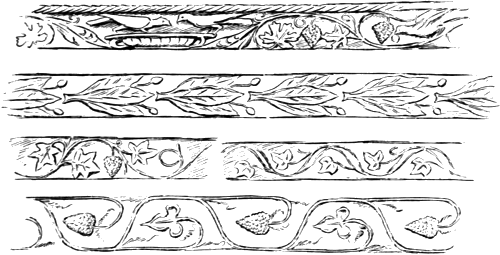
Fig. 15.—Ornaments from early Christian Coffins, Constantinople.
The coffins found in England are not so much Roman as strictly Anglo-Roman, for far more have been found here than in any other country, such as have been found in France are near our shores as if certainly made of our lead, and the ornamentation of the English examples has a common likeness in the use of the scallop shell which is not represented abroad. The comparison can best be made in a little book by the learned archæologist Abbé Cochet of Rouen, Les Cercueils de Plomb (1871), in which the examples found in France are figured.
These English coffins and sepulchral cists are mostly in the British Museum and at Colchester. The cists are plain circular boxes some ten inches diameter by fourteen inches high;[42] one of these is decorated by simple circles and another has crossed rods of “reel and bead,” with applied small panels of chariots and horses.
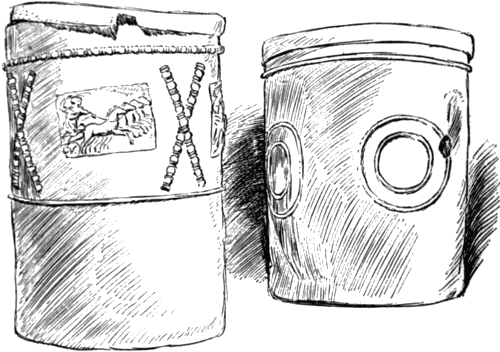
Figs. 16 and 17.—Cists, British Museum.
The coffins have been found chiefly in the London district—in the Minories, Stepney, Stratford; at East Ham, Plumstead in Kent (this last is now in Maidstone Museum)—at Southfleet and at Colchester and Norwich. They are decorated by rods of “bead and reel” differently arranged on the lids in zig-zags or lozenges, with scallop shells and plain rings placed in the spaces. The rods and shells were evidently separately impressed into the flat field of the sand mould and that with the artful carelessness which shows[43] that the designer and the workmen were one and the same person, an artist. With these simple elements compositions are made of quite classic distinction and grace. Mr. Alma-Tadema apparently drew the fine leaden oleander tub in his picture from these coffins, and it makes a perfect flower-pot.
A coffin found at Pettham in Kent was decorated by a simple cord which passed around once transversely in the middle and then each of the spaces thus formed on lid, sides, and ends had diagonals of cord. A fragment of one in the museum at Cirencester is more finished and refined, it has a saltire of the twisted bars with terminations at their ends, and in one of the spaces is a small female head.
The coffins are made like a modern paper box with a lid lapping over the sides. Some sketches are given from those in the British Museum. That shown in Fig. 19 was of full length (6 ft.) but only a part of the lid remains. The other two (Figs. 18 and 20) are less than 4 ft., one of which is ornamented with rings and ropes and curious forms like the letter B. Those at Colchester are like the former. These coffins are all very white with oxide.
[44]
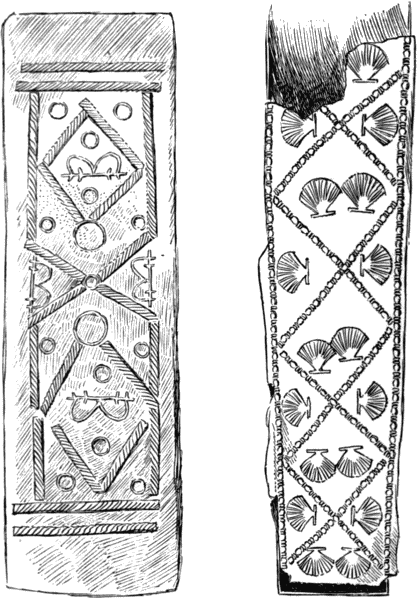
Figs. 18 and 19.—Roman Coffins, British Museum.
The French examples have been found at Boulogne, Beauvais, Amiens, Angers, Rouen, and Valogne near Cherbourg, but none are like the English in having rods of beads with scallop[45] shells. One has only groups of rings which, simple as it is, makes a design. Another at Rouen has a human head in a circle at the centre with six lions’ heads in octagons. That at Valogne has a trunk-shaped lid with flying genii and birds; and one at Nismes has lions and griffins, and between each pair persons planting a vine.

Fig. 20.—Roman Coffin, British Museum.
There is just enough evidence to show that the use of leaden coffins was continued by the English after they had superseded the Romans. St. Guthlac, Abbot of Croyland, was, Leland says, buried in a sarcophagus of lead. And St. Dunstan was buried at Canterbury in a lead coffin.
[46]
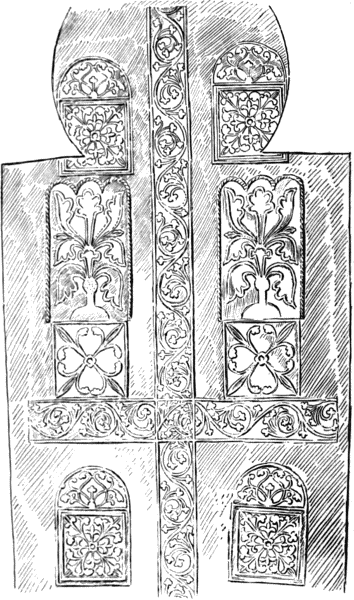
Fig. 21.—Thirteenth Century Coffin, Temple Church.
Directly after the Conquest we find them in use. At Lewes there[47] are two coffins of De Warren (1088), and his wife the daughter of the Conqueror (1085); they are covered with the reticulated meshes of a net, both sides and lid as if cast from actual netted cord. At the heads are the names WILLELM, GVNDRADA.
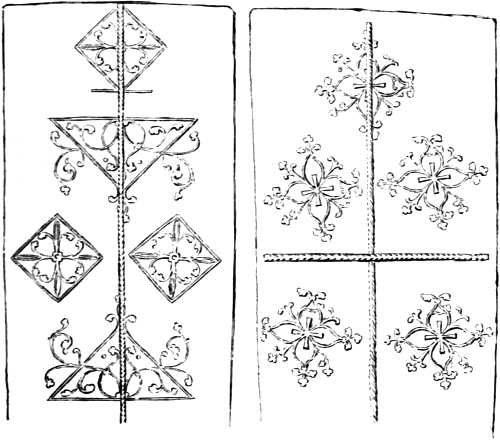
Figs. 22 and 23.—Thirteenth Century Coffins, Temple Church.
St. Dunstan was re-interred in the new work, at Canterbury in 1180 in a coffin of lead which was “not plain, but of beautiful plaited work.”
Some most remarkable coffins thus decorated were discovered in 1841 in relaying the floor of[48] the Temple Church in London; the style of their design would show that they were made about the year 1200. They contained the bodies represented above them by the cross-legged stone effigies of knights. These coffins were drawn and published by Mr. Edward Richardson in 1845, from whose careful drawings are made the accompanying illustrations.

Fig. 24.
The extreme delicacy of the ornament is most remarkable. Here again the pattern design is made up of portions several times repeated in similar or different combinations; the panels were either cast to the required number and then arranged on a board from which the final mould was made; or the parts were impressed separately in a smooth and level surface of moulding sand, and this with all the rapid ease of self-sufficient art. They are about 6 feet 6 inches long, and some are formed like the stone coffins of the time with a circular end for the head. The sides as well as the covering are decorated in the richest example by two of the same small[49] square patterns alternating, and in others by vertical cords at intervals.
At Winchester there has recently been exposed a fifteenth century coffin bearing on the lid a cross and the arms of the Bishop Courtenay. (Fig. 24.)
Later the form was made to conform more closely to the body, being rather a wrapping than a box. That of Henry IV. (1413) at Canterbury was of this form, as also was that found at Westminster under the tomb of Henry VII., the latter had a small cross at the breast only.
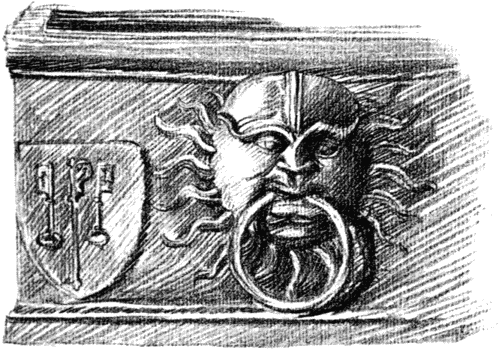
Fig. 25.—At Moissac.
The heart-box of Richard Cœur de Lion is mentioned in another place. There is a heart casket in the British Museum, circular and much[50] like a flower-pot; on the lid is the device of a spear-head within a garter, and engraved outside is this inscription:—“Here lith the Harte of Sir Henrye Sydney. Anno Domini 1586.”
A fine coffin (Fig. 25) is represented in the lead group of the entombment at Moissac in France. This is 15th century work.
[51]
England is extremely rich in the possession of early fonts in lead; these are for the most part alike in being of the twelfth or early thirteenth century. Nearly all of them agree in being circular and have other similarities which with many repetitions in their design would seem to relate them to one family. As in Sussex there are in the neighbouring villages of Edburton and Piecombe two fonts substantially alike, and in Gloucestershire another pair, with others that have close resemblances; they have been claimed for local manufacture, yet a strong case could be made out for most of them coming from one common centre. As, further, there are several specimens in Normandy entirely parallel, the question arises whether the type arose here or there, for there can be no doubt as to one set being indebted to the other. As England was so especially a lead producing and exporting country, and as such a number of these fonts remain with us broadly scattered over the country, while there are but comparatively few in[52] France, and those mostly in Normandy, this, with the local coincidences pointed out, would seem to give us the best claim.
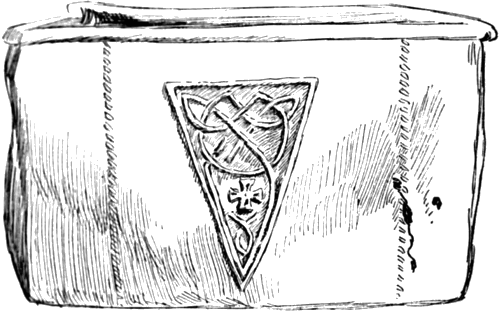
Fig. 26.—Vessel, Lewes Museum.
There is in the Lewes Museum a lead cistern-like object of Saxon work, which is represented in Fig. 26. It is about 14 inches long and 8 inches high, the sides are decorated with triangles of interlacing patterns cast with the lead. It has two handles of iron; but as it would be much too heavy for a movable vessel, and as the small foreign lead font in Kensington Museum has handles also, it is probably a font. The cross in the decoration would go to confirm this.
Some of the fonts of Norman date it cannot be doubted were made in England. But unless we would claim the two figured by Viollet-le-Duc[53] and that at St. Evrault-le-Montford which is similar to ours at Brookland described below, we can hardly claim to have made all our own. Possibly examples were brought here, as was the case with several black stone fonts in England.
Some of these lead fonts (that at Wareham for instance) appear to have been cast in one piece. But for the most part they are small low cylinders cast flat in sheet with the ornaments repeated usually more than once in the sand mould; the casting was then bent round and soldered. In one case, where it is not joined so as to form a cylinder, but with the sides spreading to the top, the band of ornamentation which was straight on the sheet runs up as it approaches the joint in a most amusing way. The patterns consist of delicate scroll-work, arcades and boldly modelled figures 10 or 12 inches high; a moulding strengthens the upper and lower edges. They stand on stone pedestals.
There are altogether some twenty-eight or thirty of these fonts in England.
[54]
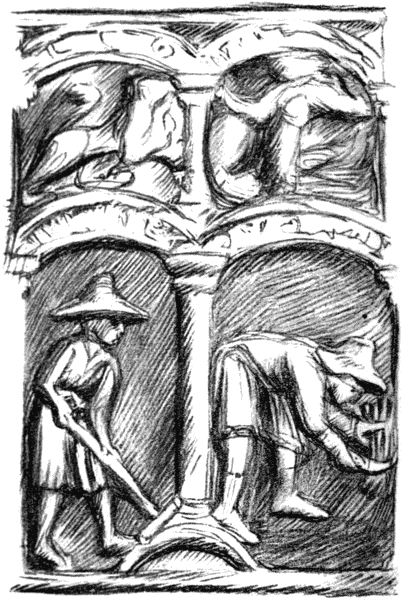
Fig. 27.—Font, Brookland, Kent.
The font at Brookland at Kent is very small, only 11 inches high, an arcade surrounds it of two stages in twelve bays. In the upper tier are the signs of the Zodiac with their Latin names, and below the subjects of the labours appropriate to the months with their names in Norman French. This scheme of imagery is well known abroad but while often occurring in English MSS. this is one of very few examples of its[55] treatment in sculpture. Although the scale of the figures is small and they are but slightly modelled, there is a great deal of character, appropriateness, and grace, in their gesture.
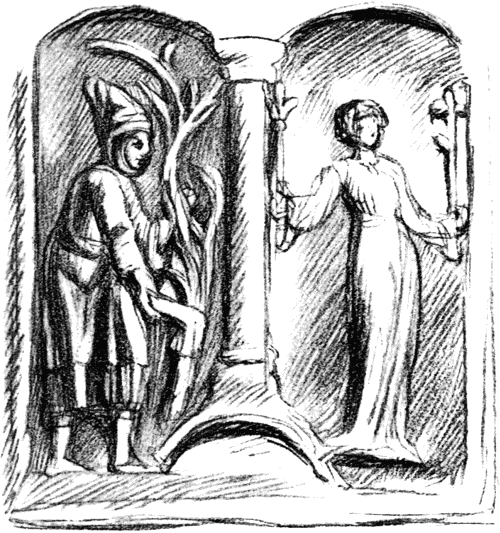
Fig. 28.—Font, Brookland.
A comparative table of the usual scenes which accompany the signs has been given in Archæologia, and another, probably more accessible, in the Stones of Venice. With the examples[56] there given the scenes on the font very closely agree. They are inscribed in capitals:—
The signs are thus represented:—Aquarius, man pouring water from a jug. Pisces, two fish as usual reversed. The ram and the bull are much alike. The twins and the crab are not remarkable, except the latter for unlikeness. Leo is a good heraldic beast. The Virgin, much obscured. Libra, a man with scales. Scorpio, is certainly a frog. Sagittarius, a centaur. Capricorn is indeed a capricious creature like a cockatrice with horns. The forequarters of a goat with fish-tail is the traditional form for this sign handed on from the Roman Zodiac.
In the months, the Mower, the man raking, and especially the Reaper, are well designed; the man pruning is also good, and the girl with the[57] long stalked lilies in her hand is charming. The four last are shown in the sketches given. The pillars are varied, every third standing on the loop as shown.
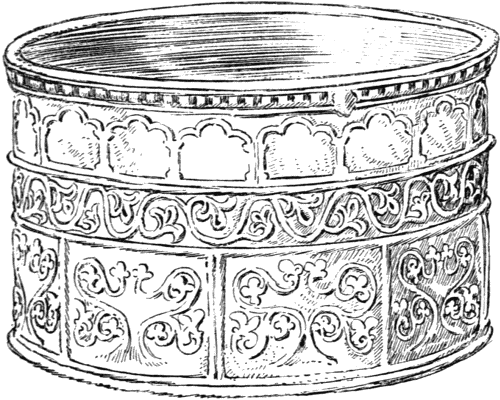
Fig. 29.—Font, Edburton, Sussex.
The font at Edburton in Sussex is 21 inches in diameter and 14 inches high; it has a wide band of foliage and at the top a row of trefoil panels. At Piecombe, the adjoining parish, the upper row of small trefoil arches and the narrow band of ornament are the same, but instead of the lower panels there is a row of round-headed arches.
[58]
At Lancourt, or Llancault, and Tedenham in Gloucestershire there are fonts in duplicate. These are much larger, 2 feet 8 inches in diameter by 1 foot 7 inches high. An arcade of twelve arches surrounds the bowl; each compartment has a throned figure or a panel of foliage alternately. There are two varieties of figure and foliage, each is thrice repeated and the little columns are twisted and decorated. These two fonts are evidently of the twelfth century.[11] At Frampton-on-Severn is a font with similar seated figures and foliage.
At Wareham in Dorsetshire the font is hexagonal with two standing figures under arches in each face, twelve altogether. The sides instead of being vertical slope outwards. The style seems central Norman not transitional, like several of the examples.
At Dorchester, Oxfordshire, the bowl is 2 feet 1 inch diameter 14 inches deep, it has an arcade wholly of seated figures of bishops. It is a very beautiful work, the figures are extremely well modelled, and the whole in good condition, the lead of great substance.
Walton-on-the-hill, Surrey, has a similar font 14 inches high, surrounded by an arcade, and in each compartment a sitting figure. A sketch of one arch given is necessarily rough, as the modelling, even at first soft and sketchy, has suffered some injury in the use of 700 years.
[59]
At Wansford, Northamptonshire, is another of these with arcades and figures.[12]
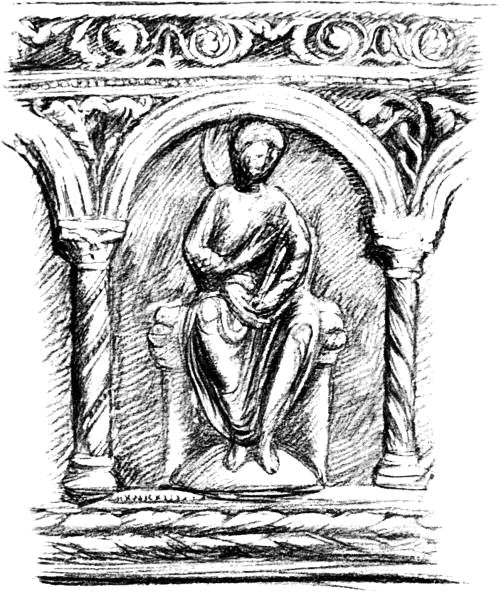
Fig. 30.—Font, Walton, Surrey.
At Childrey, in Berkshire, there is also a font with twelve mitred bishops with pastoral staffs and books.
[60]
Another at Long-Wittenham, in the same county, has the arcade at bottom of very tiny pointed arches of some thirty bays with figures, above are panels with discs and rosettes.[13] One at Warborough, in Oxfordshire, is similar in style, made in the same workshop apparently. The bottom half has a small arcade interrupted after every four arches by three higher ones: in the twelve small niches are figures of bishops with mitre and staff and lifted hand in benediction, the three high arches and the space above the little ones have discs of ornament, the bishops are repeated from one pattern; the size is 1-3 in height by 2-2 diameter.[14]
Woolhampton, in Berkshire, has a font in which the lead is placed over stone and pierced, leaving an arcade and figures showing against the stone background.
The font at Parham is of later Gothic. Mr. André gives an account of it in Vol. 32, Sussex Archæological Society; it is only 18 inches in diameter, and a portion of the bottom is hidden by being sunk into the stone block on which it stands. The decoration is made by repeats of a label bearing + IHC NAZAR placed alternately upright and horizontally with small shields in the interspaces which are said to bear the arms of Andrew Peverell, knight of the shire in 1351. The style of the lettering would[61] seem earlier than this. IHC NAZAR was frequently engraved on the front of knights’ helmets. This is an extremely good example of how a fine design may be made of simplest elements.
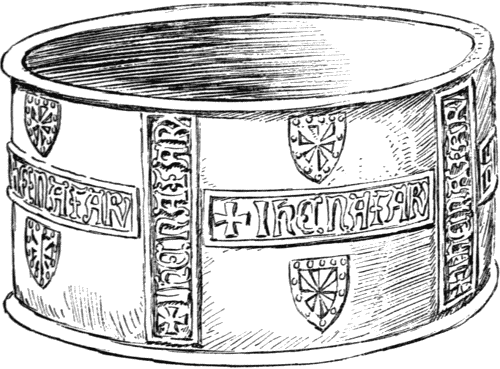
Fig. 31.—Parham, Sussex.
A Norman font of lead at Great Plumstead was destroyed with the church in the fire of December, 1891. It is figured by Cotman.[15]
The font at Avebury, Wiltshire, has often erroneously been stated to be of lead; there is a resemblance in the design, but it is of stone painted.
[62]
At Ashover, Derbyshire, the stone font has leaden statues of the Apostles.
There is a seventeenth century lead font at Clunbridge, Gloucestershire.
A complete list as far as possible follows:—
| Berkshire | Childrey and Long-Wittenham, Clewer, Woolhampton, and Woolstone (Norman) |
| Derbyshire | Ashover (Norman) |
| Dorsetshire | Wareham (Norman) |
| Gloucestershire | Frampton-on-Severn and Llancourt (similar, Norman) |
| Siston and Tidenham (Norman) | |
| Gloucester Museum (Norman) | |
| Clunbridge (1640) | |
| Kent | Brookland (Norman), Chilham, and Eythorne (the latter dated 1628, a copy of a Norman original) |
| Lincolnshire | Barnetby-le-Wolde (Norman) |
| Norfolk | Brundal, Hastingham (Norman) |
| Northamptonshire | Wansford |
| Oxfordshire | Clifton, Dorchester, Warborough, (Norman) |
| Somerset | Pitcombe |
| Surrey | Walton-on-the-hill (Norman) |
| Sussex | Edburton and Piecombe (early English) |
| Parham (Decorated) | |
| Wiltshire | Chirton |
Two of the French fonts are figured by Viollet-le-Duc,[16] that at Berneuil is of the twelfth century and very similar to that at Tidenham[63] in Gloucestershire, with alternate arches occupied by figures and foliage.
At Lombez (Gers) is a very beautiful example, small and delicate, with two girdles of decoration, the upper row continuous foliage and figures, but made up of one scene, a man discharging an arrow at a lion and a basilisk, five times repeated; the lower row has sixteen quatre-foils with figures of four varieties repeated, these are the religious orders. It is remarked that the decorations were evidently “stock patterns” because the upper row is much older than the lower, which is of the late thirteenth century.
At Visine (Somme) is one of the fifteenth century with separate cast figures in sixteen niches.
At Bourg-Achard, in Normandy, is another lead font,[17] and one is also in the Museum of Antiquities in Rouen, this last has a long inscription and date, 1415. There is a cast of one of these fonts in the Trocadero collection in Paris.
At St. Evrouet-de-Monford (Orne) is another very similar to our Brookland font with Zodiac and Seasons.
In Germany, at Mayence, there is a very fine example of the fourteenth century. And in the South Kensington Museum is a copy of a small circular lead font in the Berlin Museum;[64] this is cast in one piece, it stands on three lions’ feet and has two handles, around it is an inscription in Lombardic letters. It was presented to Treves by Bishop Baldani in the thirteenth century.
[65]
A sheet of lead is a most inviting surface for inscriptions, as may be seen by making a trip to the leads of some cathedral or castle and inspecting the series of names, dates, hand-marks and foot-prints left by generations of plumbers and visitors. So lead has been one of the chief materials used for written documents, not merely ephemeral, and even now it would be difficult to find anything more ready to receive the legend, more enduring to transmit it, and so easily decorated with the charm of art which makes an object worthy to live. Our first illustration shows the foundation record of an Egyptian King inscribed on lead.
It was the custom also in ancient Babylonia to insert inscriptions below the foundation stones of the great temples and palaces. In 1854 Place found at Khorsabad the memorial inscriptions of the great palace of the later Sargon, father of Sennacherib, a building founded in the eighth century before our era. There were five of these inscribed plates all of different metals, gold, silver, antimony, copper,[66] and lead; the four former are in the Louvre, but the lead, which must thus have been of some size, “was too heavy to be carried off at once”; it was dispatched by raft, and was lost with most of the collection. The inscription, translated by Oppert, ends with the imprecation on disturbers which it has been the wont of great builders in all times to conjure.
“May the great Lord Assur destroy from the face of this country the name and race of him who shall injure the works of my hands or who shall carry off my treasure.”
At Dodona many tablets of lead have been found inscribed in Greek; these are questions to the oracle of that shrine.
In the British Museum there are several tablets inscribed in Greek about the area of this book and covered with text, they are for the most part imprecations on the heads of injurious persons, and were hid as a magic rite in Temple enclosures. They are quite little stories.
“Imprecation of Antigone against her accuser.”
“Imprecation of Prosodion against those who misled her husband Nakron.”
“Imprecations of a woman against some one who stole her bracelet.”
Pausanias mentions having seen a text of Hesiod which was inscribed on lead leaves; and Pliny also tells us of lead books. A lead inscribed tablet was found in the Roman[67] remains at Lydney slightly scratched with a stylus.
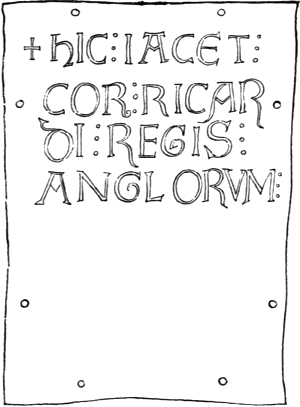
Fig. 32.—Heart Box of King Richard.
Of the Carlovingian age there are examples of lead documents in the British Museum; one being an edict of Charlemagne himself, in which he assumes the style of Emperor of the West; and it bears his well-known cypher and the date, 18th Sept., 801. Another is signed Ludovic (Louis the Younger), 822. In the Londesborough collection there is a leaden book-cover of Saxon work with an inscription from Ælfric’s Homilies.
[68]
For sepulchral use lead is especially fitted; it was customary in the twelfth century to inscribe a tablet or cross and to place it in the coffin on the breast of the dead.
In the Museum at Bruges there is a tablet with a long inscription to Gunilda the sister of Harold.[18] Two were found at Canterbury of the thirteenth century with lines of beautifully drawn Lombard capitals in incised outline with lines ruled between each row.[19]
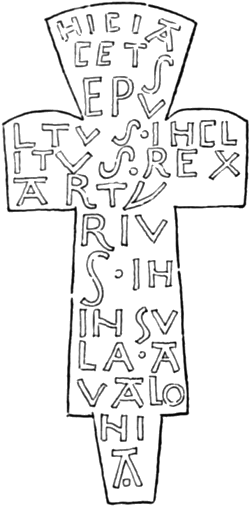
Fig. 33.—Inscribed Cross.
In 1838 was discovered in Rouen Cathedral choir the heart casket of Lion-hearted Richard, there were two boxes, one within the other, the inner one, covered inside with thin silver leaf, was inscribed with the simple words given in Fig. 32 from Archæologia (xxix).
A cruciform tablet is given in Camden[20] with an inscription purporting to record King Arthur; the form shows that it was made in the twelfth century. In the fifteenth century Chronicle[69] of Capgrave, under the year 1170, he writes—“In these days was Arthures body founde in the cherch yerd at Glaskinbury in a hol hok, a crosse of led leyd to a ston and the letteris hid betwyx the ston and the led.” He gives Giraldus, “whech red it,” as his authority. Giraldus Cambrensis gives the inscription as “Hic jacet sepultus inclytus Rex Arthurus cum Wennevereia uxore sua secunda in Insula Avalonia.”[21]
Now William of Malmesbury, who died about 1145, says distinctly that the tomb of Arthur had never been found, so this dates the fabrication of this cross by the monks of Glastonbury always so especially greedy of relics, as within a year or two of this time when Giraldus saw it (“quam nos quoque vidimus”). The inscription on the lead cross engraved by Camden agrees word for word with the exception of “with Guenevere his second wife.” Must we not suppose that Giraldus here improved even upon the monks, and added this poetic touch himself?
Few of these absolution crosses have been found abroad; one discovered in Perigord was inscribed on the arms LVX . PAX . REX . LEX.
Wall tablets in churches are represented by one at Burford in Shropshire, the monument of Lady Corbett, 1516. Her effigy is incised under a canopy much like the brasses of the same time, and it suggests simple decorative possibilities, such as filling cavities with mastics of several[70] colours, parcel gilding, damascening in brass wire, or inlay of metal on metal.
In Saltash Church, Cornwall, a lead tablet records that “This Chapple was repaired in the Mairty of Matthew Veale, Gent. Anno 1689.”
Inscriptions may be either cast with raised letters, engraved like the early ones, or punched. Ornamental borders might also be made up of punched lines, loops and dots.
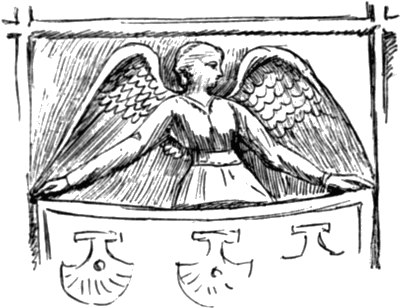
Fig. 34.—Arms from Bourges.
Of Coat Arms there was an instance at Jacques Cœur’s house in Bourges, which is quite a lead mine. The Angel shield bearer alone remains, with signs of the erasure of the arms. In London, about Copthall Buildings, in the City, are several tablets with the arms of the “Armorers Brasiers,” as also a large number of shields of cast lead with dates and initials or names of the City wards. The insurance companies also used shields of stamped lead.
[71]
In Vere Street, Clare Market, over the angle of what is at present a baker’s shop, there is a panel with two negroes’ heads in relief, and the legend “S. W. M. 1715.”
We began with a foundation inscription, we will conclude with one twenty-six centuries later. This is a large cast plate of lead 3.6 by 2.4 and an inch thick, now preserved in the Guildhall Museum, which was laid in the foundation of old Blackfriars, then Pitt Bridge:—
“On the last day of October in the year 1760 and in the beginning of the most auspicious reign of George III., Sir Thomas Chitty, Knight, Lord Mayor, laid the first stone of this bridge undertaken by the Common Council of London (in the height of an extensive war) for the public accommodation and ornament of the city (Robert Milne being the architect) and that there may remain to posterity a monument of this city’s affection to the man who by the strength of his genius, the steadiness of his mind, and a kind of happy contagion of his probity and spirit, under the divine favour and fortunate auspices of George II., recovered, augmented and secured the British Empire in Asia, Africa, and America, and restored the ancient reputation and influence of his country amongst the nations of Europe.
“The Citizens of London have unanimously voted this bridge to be inscribed with the name of William Pitt.”
[72]
One of the most usual methods of decorating lead was to gild it; whole domes were gilt in this way. The dome of St. Sophia at Constantinople seems to have been so treated, and the great arc of gold dominating such an Eastern city must have been a most impressive sight. Many of the late domes are partly gilt, as at the Invalides in Paris. The roof of the ancient basilica at Tours is said to have been like “a mountain of gold.”
Old recipe books of the last century give instructions for gilding lead. The following are examples:—
“Take two pounds of yellow ochre, half a pound of red lead, and one ounce of varnish, with which grind your ochre, but the red lead grind with oil; temper them both together; lay your ground with this upon the lead, and when it is almost dry, lay your gold; let it be thoroughly dry before you polish it.”
For another ground—“Take varnish of linseed oil, red lead, white lead and turpentine; boil in a pipkin and grind together on a stone.”
[73]
“Or take sheets of tinfoil, and grind them in common gold size; with this wipe your pewter or lead over; lay on your leaf gold and press it with cotton; it is a fine gilding, and has a beautiful lustre.”
Dutch metal was also used on a ground of varnish and red lead, as in second recipe; or gilt leaves of tinfoil on white lead ground in linseed oil, this last took a polish “as if it had been gilded in fire.” Dutch metal should be lacquered on the surface. A cheap substitute for gilding could doubtless be made for large surfaces by laying tinfoil lacquered gold colour. Or for statues the surface of the lead might be made bright and lacquered.
The external gilding on the Ste. Chapelle in Paris was done in leaf gold on two coats of varnish.
Smaller decorative objects of lead in the middle ages were often entirely gilt or parcel gilt in patterns; for instance, in an inventory of 1553 we find an altar cross “of lead florysshed withe golde foyle.” The effect of silver is obtained by “tinning” with solder, and when this is intended to form patterns on the surface of the lead the method is thus described by Burges. The surface is coated with lamp black mixed with size; the pattern is either transferred on it or drawn direct and then marked round with a point; all the part to be tinned has the surface removed by a “shave hook” so as to leave the[74] pattern quite bright, a little sweet oil is rubbed over this and the solder is applied and spread in the usual way of soldering with a “copper bit.” This is more conveniently done in the shop, but the spire at Chalons was decorated in this way long after the lead covering was finished. A specimen of this work prepared by Burges may be seen in the Architectural Museum, Westminster.
Transparent colour was often applied over this tinning, which, shining through, gave it lustre; or the tinning alternated with the colour as in chevrons of tin and blue and red. We may suppose that this sort of work was done in England, for some leaded spires shown in the paintings at St. Stephen’s Chapel, Westminster, were coloured vermilion and gold, or green and white, in chevrons following the leading.
Stow also tells us that at the Priory of St. John of Jerusalem, Clerkenwell, rebuilt after a fire in 1381, there was a steeple decorated in this way which remained to his day and was then destroyed. “The great bell tower, a most curious piece of workmanship, graven, gilt, and enamelled, to the great beautifying of the city, and passing all others that I have seen.”
Rain-pipe heads at Knole have patterns formed in this way by bright tin applied to the surface. There are also heads of water pipes at the Bodleian and at St. John’s College, Oxford (see Figs. 71 and 72), treated all over with patterns of[75] chequers and zig-zags. Those at St. John’s have cast coats of arms in wreaths brightly emblazoned in gold and colours. The collars to the pipes are painted with patterns, as also are some pipes at Framlingham, Suffolk.

Fig. 35.—Incised Decoration, Bourges.
Sometimes the pattern was incised on the lead in deep broad lines, and these, when filled with black mastic, traced the pattern without any tinning. An example of this method is found in a ridge and finial sketched at Bourges—the hearts and scallop shell were badges of Jacques Cœur. Other portions of the lead work at this house are decorated by patterns in lamp-black painted on the lead. See the ridge and examples of flashings drawn in Figures 36 and 37. A ridge designed for St.[76] Vincent’s Church at Rouen, of which a drawing is preserved, is a beautiful instance of this treatment; it is divided into lengths in which branches with leaves and flowers alternate with a stiffer pattern. The spire before spoken of, at Chalons-sur-Marne, furnishes the finest example of these methods used in combination. See drawings in Builder, 1856, and in the sketch book of the Architectural Association for 1883, both by Burges. This decoration is of the fourteenth century and is thus described by Viollet-le-Duc:—“The sheets of lead were engraved in outlines and filled in with black material, of which traces may yet be seen. Painting and gilding illuminated the spaces between these black lines, and we must observe that nearly all the leadwork of the middle ages was thus decorated by paintings applied to the metal by means of an energetic mordant. The plumber’s art of the middle ages is wrought out like colossal goldsmith’s work, and we have found striking correspondence between the two[77] arts as well in the methods of application as in the forms admitted: gilding and applied colour here replace enamel.” The design is of tabernacle work with figures and the whole was clearly intended to recall a shrine of goldsmith’s work. Large engraved patterns filled with black used alone on the silvery lead become great niellos, exactly parallel to the method of treating silver.
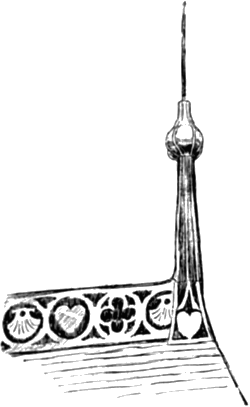
Fig. 36.—Painted Decoration, Bourges.
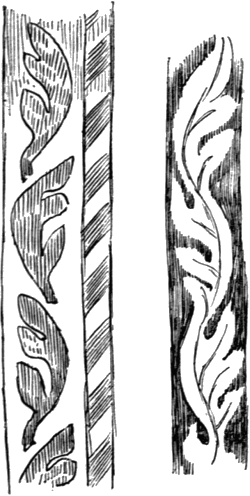
Fig. 37.—Flashings, Bourges.
The flèche called “the golden” at Amiens retains traces of arabesque patterns on grounds of bright blue and vermilion.
Repoussé by hammering, another method most appropriate to the material, was more used in France than with us, where casting has been throughout the chief means for obtaining relief decoration. In France the finials were mostly formed in this way. “Recalling the best goldsmith’s work of the epoch,” withal so easily and carelessly wrought that it is plain that they were done at once without pattern and yet with[78] ample knowledge of the ultimate form desired; so a leaf cut out of a sheet is hammered and twisted till it cups and curls itself into living grace.
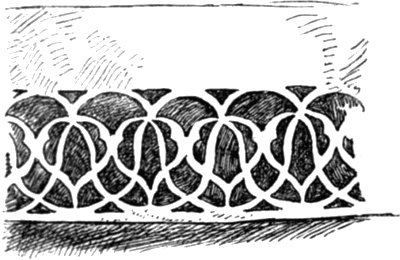
Fig. 38.—A Valance.
In these finials applied castings were also used, and at the end of the fifteenth century they superseded repoussé for a time. Many of the moulds in stone and plaster, for the ornaments which were used on the roofs and finials at Beaune are preserved. The castings were not so free and decorative however as those done by repoussé.
Of piercing into delicate tracery the pipe-heads at Haddon give many charming examples. At Aston Hall, Warwickshire, the curved lead roofs of the turrets have all round the eaves a brattishing of pierced sheet in simple scroll work, it stands up freely and gives a dainty finish: the pattern is something like that above.[79] In the East pierced valances of this kind are very general; the roofs of the larger fountains at Constantinople are usually finished in this way. Fig. 38 is from the portico roof of the Dome of the Rock at Jerusalem drawn from a photograph. Casting and piercing were also combined, the pattern being strengthened thus by ribs and the veins, and interspaces being cut away.
In small Japanese work brass is sometimes inlaid into lead or pewter in the form of flowers, which are further defined by surface engraving. Engraving on sheet lead similar to the old memorial brasses has been mentioned before, and we may go on to look at the decorative processes in which lead was used applied to other materials.
[80]
Lead trappings and appendages have often been applied to stone statues. The sceptres and bishops’ crosses of the fine fourteenth century statues of St. Mary’s spire at Oxford are of wrought lead. The leaves of the sceptre heads and the crosses are embossed out in two pieces and then soldered at the edges.
Inlaying of lead in stone slabs making grisaille designs was a method much used—a magnificent example remains in the pavement at St. Remy, Rheims (formerly in the choir of St. Nicaise in the same town), where foliated panels with figure subjects from Scripture are made out on the stones; it is a work of the early fourteenth century.[22] We have in England an example of this treatment in a tomb slab at St. Mary Redcliffe, Bristol, and there is mention of the process in the account by William of Malmesbury of the Saxon part of the “Ealde Chirche” at Glastonbury. We may well suppose this was an imitation in the national material of Roman[81] mosaic. The floor was “inlaid with polished stone ... moreover in the pavement may be remarked on every side stone designedly interlaid in triangles and squares and figured with lead, under which if I believe some sacred enigma to be contained I do no injustice to religion. The antiquity and multitude of its saints have endowed the place with so much sanctity that at night scarcely anyone presumes to keep vigil there or during the day to spit upon its floor ... and certainly the more magnificent the ornaments of churches are the more they incline the brute mind to prayer and bend the stubborn to supplication.”
The method is still followed in lettering on tombs and the like: the design is engraved in the marble and holes are drilled with a bow drill in the sunk parts, some inclined at an angle to give a better hold; strips of lead of sufficient substance are then hammered into the casements with a wooden mallet, and the superfluous metal removed with a sharp chisel.
Some of the sixteenth and seventeenth century engraved brasses have portions of the arms, etc., inlaid in lead in the brass; there are instances of this in Westminster Abbey. Lead might also be inlaid in cast iron with good effect, where it has not to be painted: the recesses would be left in the casting of either cast brass or cast iron. The stars that spangle the ceilings of churches on a blue ground are usually of cast[82] lead gilt. The ceiling of the well-known panel and rib kind attributed to Holbein at the Chapel Royal, St. James’s had the enrichments in the panels of lead. Chimney-pieces were also decorated in the same way, and even furniture is found at times with applied badges of gilt lead. These methods it must be understood are not all recommended here, they are only recorded.
The delicate applied enrichments so much used in work influenced by the practice of the Brothers Adam are in the best work of lead; cast with extraordinary delicacy in relief figure panels, after the manner of the antique, or fragile garlands, vases, and frets. Much of this work was used in the internal decoration at Somerset House. The accounts under 1780 show payments to Edward Watson—for lead pateras from 21⁄2d. to 10d. each; nineteen ornamental friezes to chimney pieces £10 17s. 8d.; lead frieze to the bookcases in the Royal Academy Library at 2s. 6d. per foot; 137 feet run of large lead frieze in the exhibition room at 4s. Dutch bracket clocks of the eighteenth century have pierced and gilt ornamentations of lead.
This method of applying pierced lead to wood was known in the middle ages. In the Kensington Museum there is a delicate openwork panel, three inches square, which with others, decorated the front of a fourteenth century chest in the[83] church at Newport, Essex. A beautiful little panel of open work, which contains the subject of the Annunciation, was found some years since in the Thames. One of the last instances of this decorative use of lead is on the great doors of Inwood’s church, at St. Pancras, where the panels are filled with reliefs and the margins have the palmette border. At Christchurch, Hampshire, some of the tracery panels at the back of the stalls have been replaced in lead.
The front door fanlights so well known in the London houses of the eighteenth century were made by applying lead castings to a backing of iron. Even staircase balustrades were cast in panels of lattice work of hard lead and fixed between iron standards some three or four feet apart.
[84]
A great number of small objects in lead are in our museums, and first we should mention the medals and plaques of the great masters of the Renaissance. Lead will cast with more delicacy than any other material, and Cellini especially recommended it for proofs. The proofs of the great work of the medallists,—the modelling just a film, fading into the background—presentments and allegories of the Malatestas and Gonzagas by Pisanello and Sperandio, are certainly the most precious things ever formed in lead. There are a great number of these medals and decorative plaques in the British Museum and at Kensington.
For coins in lead see Gaetani and Fiscorni. For tokens and pilgrim badges, of which a great number have been found in the Seine, see Gazette des Beaux Arts, Vol. VI. and XVIII. Some of these remind us of the lead figures that, according to “Quentin Durward,” Louis XI. wore in his hat. At the Guildhall there[85] is a collection of hundreds of these small objects found in the Thames; most are of great delicacy, many very beautiful. There are, in the British Museum, little Greek objects, rings and toys, armlets of a snake pattern, and pierced ornaments for applying to other objects.
Other objects in the Kensington Museum are:—A small tankard only two and a half inches diameter but modelled with figures in low relief, it is German of the sixteenth or seventeenth century; a pair of little inkstands the circular drums modelled with foliage and projecting top and bottom rims, also German; and a square canister with panel of St. George on each face.
Another is a beautiful little Gothic box of the fourteenth century. It is hexagonal, with three feet, a flat hinged cover has a sitting lion which forms the knob, a slight relief of the Annunciation under a canopy, and two shields of arms. Round the sides are delicate bands of foliage and Gothic lettering; it is three and a half inches high, and of cast lead. There are other portions of little Gothic boxes in the British Museum. At Gloucester Museum there is a square box of late fifteenth century work, the sides formed of four cast panels of lead, soldered at the angles. The panels all repeat the same relief of the dead Christ and the Virgin,[86] right and left are the other two Marys, and the background bears the cross, crown, spears, dice, and all the implements of the Passion.[23] Small canisters, and candlesticks the stems of which are formed of a little lead figure, were made quite recently.
[87]
This subject, in which lead is only secondary, has been treated so often by others in connection with glass that little more need be said here.
Already, when Theophilus wrote his treatise on the arts, some time from the tenth to the twelfth century, leaded glazing of coloured glass was practised much as we do it now, and he describes how the leads were cast with the two grooves for the glass and how it was put together on a table. Coloured glass windows were placed in the Basilica at Lyons in the fifth century, as described in the letters of Sidonius. From the thirteenth century there are crowds of examples of glazing wholly of white glass in which patterns are made by the arrangement of the leads. In the cathedrals of north France, especially Bayeux, Coutances, Mantes, and through Brittany, most elaborate patterns of this kind fill the windows; not only diapers but interlacing bands, over and under in effect, and this in plain white glass. This method does not seem to have been followed here, where for the[88] most part, unless in colour arrangements, the leading for church windows was in plain lozenges and parallelograms.
Later, however, in houses, pattern glazing, sometimes of an elaborate kind, is found, especially in the north of England, at Moreton Hall in Cheshire, at Bramhall, and at Levens in Westmorland. In some parts the glass may not be more than a circle or diamond of an inch across.
These patterns have been amply treated in other places, and we may consider those that have a diapered pattern all over the light to belong rather to the glass than the lead. There are others, however, in which the lead lines are made still more important by being arranged in a single intricate panel to each light, the centre usually being charged with an heraldic device. Two simple examples are given in Figs. 39 and 40.
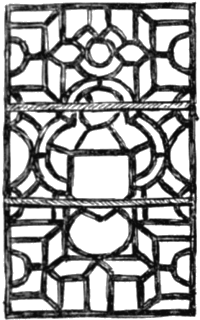
Fig. 39.
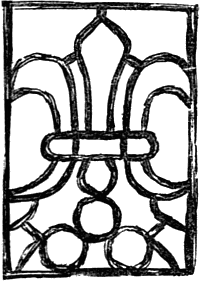
Fig. 40.
There is one point to speak of in regard to the fretted patterns not usually noticed. The frets are sometimes leaded up so that the glass does not lie in one plane, but there is an[89] intentional change, so that the faces of glass reflect the light differently in a uniform manner all over the window, the forward panes being some 1⁄3 or 1⁄4 inch in front of the plane of the inner ones and between them others are placed obliquely. This is best known in Holland, but a similar practice was followed at Levens in Westmorland.
Lozenges of lead pierced for ventilation, either one or several together, are sometimes found; they are cast with a delicate pattern, or cut in a lattice. Some of the best are in the museum of Fountains Abbey, others are at Ely and at Haddon. Fig. 41 is from a Surrey cottage.
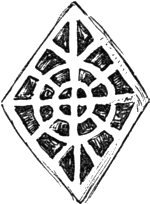
Fig. 41.
[90]
The making of lead statues was frequent up to the end of the 18th century, and then more frequent than at any other time, to cease at once on the introduction of the Italian plaster model shops, which in the eyes of the connoisseurs of the time brought with them a time of purer taste, the taste whose god was the Apollo of the Belvidere.
These statues of lead were known to the ancients. There was one of Mamurius at Rome.[24]
In the middle ages there were not only small cast lead figures like those around the font at Ashover and a figure from a crucifix now in the library of Wells Cathedral which is about 12 inches high, of 15th century work, but figures full size and more were also made; this was especially the case in France; these, however, were generally repoussé.
In the garden of the Cluny Museum in Paris is a fine figure of St. John Evangelist, fully eight feet high; it is of early 14th century work,[91] and looks as if it had stood at the central pier of a doorway.
At Moissac, in the south of France, is a most remarkable work of lead, a tomb, above which is a lead sarcophagus and several figures representing the entombment of Christ, who is being laid in the open coffin. It is 15th century work; the figures, six in all, are full of character and vigour like the wooden statuary of the time. It appears from a photograph to be cast in separate portions.
The figures formed by repoussé usually serve as finials on the roof, or stand in niches of the flèche. In the great flèche at Amiens there are six figures as large as life, with other smaller figures of angels which hold emblems of the Passion. M. Viollet-le-Duc says these figures were nearly always embouties that is to say hammered out on a wooden model in portions, and soldered together. The artist had to be careful that the model should be thin and “dry” so the thickness of the lead should not make it too coarse in the forms. Burges cites an account of 1514 of a payment to John Pothyn, sculptor, for having carved a prophet in walnut wood to serve as a mould and pattern to the lead-workers. Sometimes the lead casing was put on with lapping joints, the skeleton frame being iron.
There are not now in England lead statues of any size executed during the middle ages; but magnificent figures of bronze cast by the[92] cire perdu method remain to us. The effigy of Queen Eleanor at Westminster cannot be matched in Europe.
The founder’s art was carried to much perfection in Germany in the 15th and 16th centuries. Mr. Seymour Haden has in Hampshire a statue of a city herald of lead which formerly belonged to the great clock at Nuremburg.
Many statues of lead were set up in English towns after the earlier Renaissance, they are our national version of the bronze of Italy, a material which we used but little; such bronze statues as were cast here since the middle ages seem to have been the work of foreigners. Le Sieur, for instance, did the statue of Charles II. at Charing Cross, and many others. The statue of Queen Anne that was to surmount Gibbs’ proposed column in the Strand was ordered in Rome.
At Bristol there is a large Neptune of lead roughly modelled; the limbs are contorted with too much life and yet it is a decorative feature in the centre of a wide street. On the pedestal has been engraved a little history of the statue, an example that might be followed—“Neptune, cast and given A.D. 1588 by a citizen of Temple parish to commemorate the defeat of the Spanish Armada. Re-erected on its fourth site in 1872.” This seems to be a tradition unsubstantiated by record, but the time is not so remote that it may not as well be true, especially as the style of the[93] figure would seem to agree with the date named. The story says that it was the gift of a plumber in the town, the metal being that of the captured ships’ pumps.
At Bungay in Suffolk there used to be a large statue at the Market Cross known as “Astræa.”
One of the most interesting portrait statues in London, the Queen Anne at Queen Anne’s Gate, Westminster, is of lead. The surface ornament on the robes is especially appropriate to the material. There is also in Golden Square a statue of George II. which seems to be nearly a repeat of the stone statue on Bloomsbury steeple; it suggested the statue in Fred Walker’s picture, “The Harbour of Refuge.”
There were also many full size equestrian statues founded in this metal, that of George I., until 1874 in Leicester Square, was one of these, and like the last it was brought from Canons, the celebrated house of the Duke of Chandos at Edgware, dismantled about 1747. The George I. resembled Le Sieur’s statue at Charing Cross and was known as the Golden Horse, for the whole was gilt, as many of the statues seem to have been at Canons, in that garden where, according to Pope, “The trees were clipped like statues—the statues thick as trees.”
The statue of William of Orange at Dublin is another of these, and it is celebrated alike in political demonstrations and Catholic polemics. Cardinal Newman wrote of it, “The very flower[94] and cream of Protestantism used to glory in the statue of King William on College Green, Dublin, and though I cannot make any reference in print I recollect well what a shriek they raised some years ago when the figure was unhorsed. Some profane person one night applied gunpowder and blew the king right out of his saddle, and he was found by those who took interest in him, like Dagon, on the ground.”
Yet another equestrian statue is that of Charles the Second at Edinburgh, set up by the magistrates of the city in Parliament Square, in honour of the restoration of the king. A writer in the Athenæum for April 13th, 1850, speaks of it as the “finest piece of statuary in Edinburgh,” and urges the suitability of lead for the purpose. “In Black’s Guide through Edinburgh it is spoken of as the best specimen of bronze statuary which Edinburgh possesses; it is, however, composed of lead. Now this leaden equestrian statue has already without sensible deterioration stood the test of 165 years’ (in 1850) exposure to the weather, and it still seems as fresh as if erected but yesterday.” Some years before this, one of the interior irons having given way, a part of the shoulder sank a little and it was taken down and repaired and sufficiently proved to be lead. Taking the figures above, it appears that the date of this work is 1685.
Mr. James Nasmyth also wrote to the Athenæum, June, 1850, “to confirm as a practical man[95] the perfect fitness of lead” as a substitute for bronze, and to recommend the cire perdu method of casting, at that time discontinued in England; the process being to model the statue in wax on a solid core, to cast in plaster the finished wax model, and then to melt out the wax from this plaster mould, the space which it occupied being refilled with lead. Of course only one cast can be obtained in this way, whereas the old decorative statues spoken of later were cast in a piece mould and reproduced again and again.
“The addition (still quoting) of about five per cent. of antimony will give it not only greater hardness but enhance its capability to run into the most delicate details ... it is in every sense as durable as bronze when subject simply to atmospheric action.”
We shall see that an addition of block tin was made to the lead by the old figure founders. Type metal, which is so much harder than lead, is an alloy of lead and 1⁄4 to 1⁄3 of antimony, or of two parts of lead to one of tin and one of antimony.
In the courtyard of Houghton Tower, Lancashire, there is a statue of William III. brought from the dismantled Walton-le-Dale in 1834.
The statues decorating the parapets of the large “classic” country houses are at times of lead; there are five of these at Lyme in Cheshire. Over the portico of the Clarendon at Oxford there are four of these statues representing the[96] sciences. Until recently there was a figure of King James high up in a niche at the Bodleian.
The figures of the good little boy and girl common at charity schools are also often of lead. The great Percy lion that surmounted old Northumberland House at Charing Cross (destroyed twenty years ago) is now on the river front of Syon House; it weighs about three tons, and it was placed in its original position in 1749. The lion on the bridge at Alnwick is also of lead, as the little boy found to his cost who climbed out on its tail.
There are a series of lead busts in oval panels on the front of Ham House, Petersham, Surrey, 1610 being the date of its erection.
Before passing into the garden a word on the practical details of casting as traditionally followed may be added. The casting of lead statues is much the same process as founding in bronze, but it is simpler from the much lower temperature at which lead flows, and the ease with which limbs can be cast separately and joined to the body. The technical details may be found in a text-book of modelling and casting—Mouler en Plâtre, Plomb, &c. (Lebrun, Paris, 1860). The course followed is to cut up the model in such parts as is determined, to mould these in loam, the cores are then cast in plaster after the thickness that will be occupied by the lead has been first applied to the moulds in sand (terre). The cores are then removed and dried and baked, for in this as[97] in all founding everything depends on the absolute dryness of the mould. After the first mould had been added to, for the casting of the core, a second mould would be prepared from the original figure and the core supported in that by irons. The castings are then made, and the portions reunited and finished on the surface. Large works have to be sufficiently supported with internal irons. All the mysteries of vents, and false coring when necessary, can only be understood by practical familiarity with founding.
Modern figures for Dundee were cast from plaster; cast iron also makes good moulds.
If the roof is the place for those earlier figures formed by repoussé, the garden is rightly inhabited by cast lead statues. It is a material in which the designer might well permit himself slightness, caprice, or even triteness. A statue that would be tame in stone, or contemptible in marble, may well be a charming decoration if only in lead, set in the vista of a green walk against a dark yew hedge or broad-leaved fig, or where the lilac waves its plumes above them and the syringa thrusts its flowers under their arms and shakes its petals on the pedestal. “How charming it must be to walk in one’s own garden, and sit on a bench in the open air with a fountain and a leaden statue and a rolling-stone and an arbour. Have a care though of sore throat and the agoe.[25]”
[98]
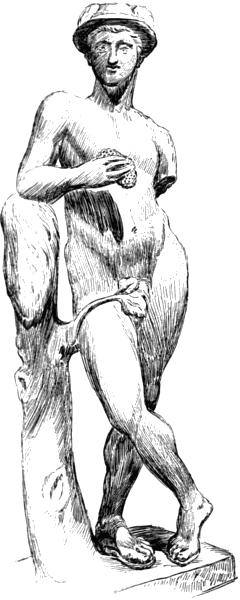
Fig. 42.—Mercury.
[99]
When sculptors learn again that their art is to shape many materials in various ways for diverse uses, and that a statue is not necessarily of whitest marble or to be exhibited on the 1st of May, then we may get back the delight of sculpture in the garden.
Sculptured marble, unless the art is of a high order, does not please us out of doors by a pond or on a terrace, if it is not weathered down to a ruin, but lead is homely and ordinary and not too good to receive the graffiti of lovers’ knots, red letter dates and initials. Here is a sketch of a Mercury not at all too fine for further decoration of this sort; it came from a London sale room, the surface was quite white and exfoliated like old stone. The jaunty messenger has a garden thought too, for it is honeycomb in his hand.
One of the best known of these garden statues was a group of Cain and Abel that so recently gave an interest to the great grass quad of Brasenose College, Oxford. It was given by Dr. Clarke, of All Souls, “who bought it of some London statuary.” Hearne speaks of it as “some silly statue”—superiority has always been the greatest enemy to beauty. Forty or fifty years ago there was a Mercury in Tom Quad which has also been improved away.
[100]
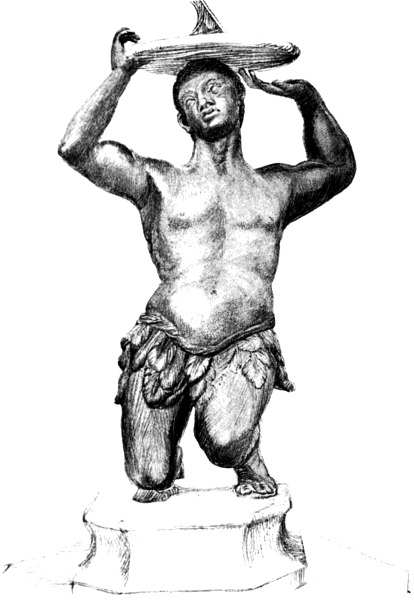
Fig. 43.—Sun-dial, Temple Gardens.
Our next example fulfils a purpose. It is the sun-dial formerly in Clement’s Inn, which was known locally as the “Blackamoor.” It is[101] strongly, if simply modelled, a piece of art full of character, and we may be glad that it has been restored to us although now placed in the gardens of the Inner Temple, instead of before the “Garden House” in Clement’s Inn.
The negro is the full size of life and bears the stone disc of the dial on his head with one hand, the other being free. The dial is beautifully engraved and is signed on the edge of the gnomon Ben Scott in the Strand Londini Fecit. The sides have the initials of the donor, P. I. P., and the date, 1731. Mr. Hare in his Walks in London states that it was brought from Italy late in the seventeenth century by Holles Lord Clare, whose name is preserved in the neighbouring Clare market. This statement is also found in Thornbury’s Old and New London, and the statue is said to be bronze, which it is not, nor do the initials and date above agree with Mr. Hare’s statement, who goes on to remark that “there are similar figures at Knowsley, and at Arley in Cheshire,” but he does not say if these also were brought from Italy by Lord Clare.
No authority is given by Mr. Hare, but his statement is in the main a transcript from John Thomas Smith, who also gives the verses quoted by Mr. Hare, said to have been attached to the statue on one occasion with a pitying reference to the legal atmosphere the African had to breathe. That it was brought from Italy is[102] seemingly local gossip added to the account of Mr. Smith who knew well enough the English workshop, as we shall see, where these figures were made.
Similar figures are mentioned by this writer in his gossiping Antiquarian Rambles in London in which he wrote the memories of his own travels in the streets in the beginning of the present century, and gives quite a history of this “despicable manufactory.” The founding of these lead garden statues seems specially to have been an industry of the eighteenth century; with the dreary opening of the nineteenth “a purer taste,” so we are assured, banished these and most other charms of an old-fashioned garden. “In Piccadilly, on the site of the houses east of the Poulteney Hotel including that, now No. 102, stood the original leaden figure yard, founded by John Van Nost, a Dutch sculptor, who came to England with King William III. His effects were sold March, 1711.” As late as 1763 a John Van Nost (supposed descendant of the former) was following the profession of a statuary in St. Martin’s Lane, on the left, a little farther up than where the old brick houses now stand in 1893. The original business was taken in 1739 by Mr. John Cheere, who served his time with his brother, Sir H. Cheere, the statuary who did several of the Abbey monuments.
“This despicable manufactory must still be[103] within memory, as the attention of nine persons in ten were arrested by these garden ornaments. The figures were cast in lead as large as life and frequently painted with an intention to resemble nature. They consisted of Punch, Harlequin, Columbine and other pantomimical characters; mowers whetting their scythes; haymakers resting on their rakes; gamekeepers shooting; and Roman soldiers with firelocks; but above all an African kneeling with a sundial upon his head found the most extensive sale.
“For these imaginations in lead there were other workshops in Piccadilly, viz., Dickenson’s, which stood on the site of the Duke of Gloucester’s house, Manning’s at the corner of White Horse Street, and Carpenter’s, that stood where Egmont house afterwards stood.
“All the above four figure yards were in high vogue about the year 1740. They certainly had casts from some of the finest works of art, the Apollo Belvidere, the Venus de Medici, &c., but these leaden productions, although they found numerous admirers and purchasers, were never countenanced by men of taste; for it is well known that when application was made to the Earl of Burlington for his sanction he always spoke of them with sovereign contempt, observing that the uplifted arms of leaden figures, in consequence of the pliability and weight of the material, would in course of time appear little better than crooked billets.... There has not been[104] a leaden figure manufactory in London since the year 1787, when Mr. Cheere died.”
Walpole knew little of these lead-working sculptors, his only notice occurring under “Carpentier or Charpentiere”—our Carpenter above—“a statuary much employed by the Duke of Chandos at Canons, was for some years principal assistant to Van Ost (our Van Nost) an artist of whom I have found no memorials, and afterwards set up for himself. Towards the end of his life he kept a manufactory of leaden statues in Piccadilly and died in 1737, aged above sixty.” The original Van Nost came from Mechlin, and married in England the widow of another Dutch sculptor.
In the account books of the building of Somerset House the following entry, which occurs under 1778, is interesting as showing John Cheere working on particular works, and for giving us the composition of the metal and the price. “John Cheere, figure maker; to moulding, casting, and finishing four large sphinxes in a strong substantial manner, lead and block tin, at each £31.”
It is curious if Lord Burlington gave the critical dictum attributed to him, that there were so many lead garden statues at his villa at Chiswick, in 1892 dismantled by the Duke of Devonshire. Doubtless they belonged to that garden described by Walpole as in the Italian taste, where “the lavish quantity of urns and[105] sculpture behind the garden front should be retrenched,” a wish that time accomplishes. There was a Bacchus, a Venus, an Achilles, a Samson, and Cain and Abel.
In the first quadrangle at Knole there are two good reproductions of the antique, one being a crouching Venus. In the courtyard of Burton Agnes in Yorkshire stands a Fighting Gladiator.
Studley Royal, near Ripon, is a fine example of the best effort of park-gardening, if the phrase be allowed, for the term “landscape gardening” is degraded to mean productions in the cemetery style, an affair of wriggling paths, little humps, and nursery specimens, which might best be described as cemetery gardening, and between which and the manner of Kent there is no parallel. Here lakes in ordered circles and crescents occupy the grassy flat between hanging woods, and several groups of lead statuary stand above the water.
In the beautiful old gardens at Melbourne in Derbyshire are a large number of lead figures, two of which are drawn in The Formal Garden.[26] There are two heroic sized figures of Perseus and Andromeda beside the great water; a Flying Mercury after Giovanni Bologna; two slaves, which are painted black, with white drapery, carrying vases on salvers; and several Cupids in pairs or single. Of these “the single figures” Mr. Blomfield says “are[106] about two feet high. One has fallen off his tree, another is flying upward, another shooting, another shaping his bow with a spoke shave. All of these are painted and some covered with stone dust to imitate stone, a gratuitous insult to lead which will turn to a delicate silver grey if left to its own devices.”
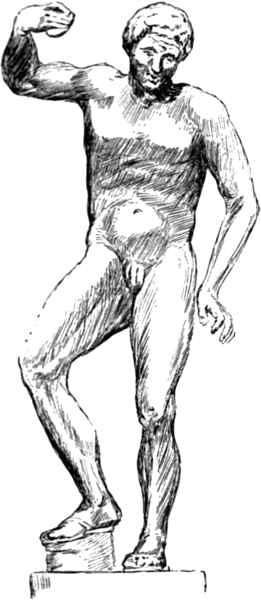
Fig. 44.—Cymbal Player.
In the old gardens at Rousham described by Pope are still some Cupids riding on swans; at Holmerook Hall are statues and other objects in lead, and at Newton Ferrars in Cornwall are two statues of Mars and Perseus. At the Mote House, Hersham, are some garden figures.
There are also some figures of lead in the gardens of Castle Hill, Lord Fortescue’s house in Devonshire. In the[107] two niches of a garden temple there is a Cymbal Player from the antique and a Venus in the manner of William and Mary. Amongst the foliage of a wood-path is a terminal figure of Pan, the pillar being stone and the head and shoulders only of lead. In the gardens here are also two large couchant lions, four sphinxes, and some greyhounds. At Nun Moncton in Yorkshire, on a terrace by the river Ouse are several lead figures on each side of the walk, these have gilded trappings. At Glemham in Suffolk are figures of the Duke of Marlborough and Prince Eugène at the entrance. In the garden are two black slaves with sun-dials, and the Seasons: also hounds at the gateway.
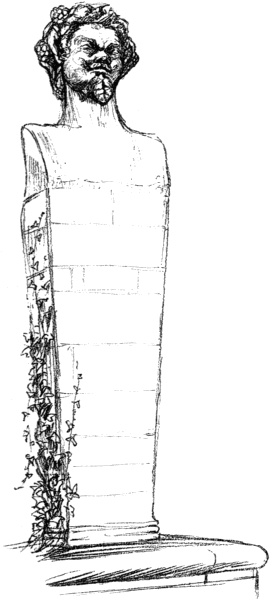
Fig. 45.—Terminal at Castle Hill.
[108]
In the garden at Canons Ashby is a figure of a shepherd playing a flute. In a garden at Exeter are four or five figures, amongst which is a Skater and a Flower Girl, and at Whitchurch is a Quoit Thrower.
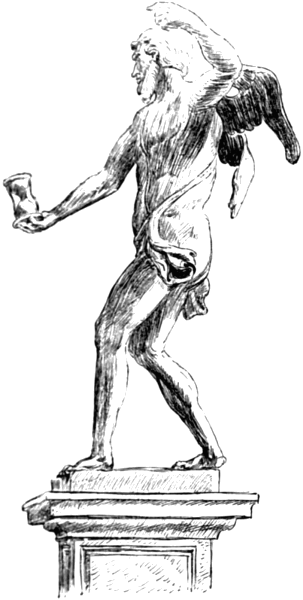
Fig. 46.—Time.
In the niches of a large circular yew hedge at Hardwick are four figures, three are playing on musical instruments; pipe, trumpet, and violin, and the fourth represents Painting. There are also two other figures in the gardens. At Temple Dinsley near Hitchin is a figure of Time, hour-glass in hand, of which a sketch is given. The left hand formerly held a scythe, now lost. At Shrewsbury is a Hercules.
The statues in the grounds at Blarney[109] celebrated in the “Groves of Blarney” were of lead:—
These statues were sold by auction to Sir Thomas Dene who bought the castle, and pictures:—
The eighteenth century must have been busy in the “manufacture” of these garden figures and ornaments, some of the gardens mentioned have as many as twenty to thirty pieces still. A great number was doubtless absorbed in the London public gardens and the villas up the Thames. In old Vauxhall was a statue of Milton by Roubilliac, but it is difficult to attribute many specimens to individuals. The negro we saw was sold by Mr. John Cheere in St. Martin’s Lane, but likely enough the model was a part of the stock of Van Nost, as also the fine vases at Hampton Court. Many of these statues were destroyed to suit the “purer taste” of this century, and a great number were exported during the American[110] War to become bullets, because at that time as “works of art” the lead escaped the Customs. A large number have been accidentally crushed by the fall of a tree or otherwise destroyed, and many not adequately supported have flattened down out of shape.
There was a large display à la Louis Quatorze, of lead casting in the gorgeous gardens of Versailles; where in the fountains, groups of statues, and vases, the greatest sculptors of the time worked indifferently in marble, bronze, or plomb doré. François Girardon was one of these. Born in 1628, at Troyes, he lived to the year 1715, achieving a reputation that placed him amongst the foremost of French artists of that time.
The immense structure entirely of lead known as the Fountain of the Pyramid is his work. From a basin in which sport three man-sized tritons rises a pedestal, with a circular basin much enriched by gadroons, set on three classic zoomorphous legs; and above it three other like basins of diminishing size, each supported from the one below around the rim; by baby tritons for the lowest, the next with dolphins, and the last with lobsters. In the last basin is a vase. The whole is a composition showing great refinement of scholarship, recalling in general form the great pine cone of bronze in the Vatican gardens, once the fountain in the atrium of old St. Peter’s. It is exquisitely drawn and[111] engraved by Rouyer et Darcel[28] together with two vases also of lead from the Basin of Neptune.
Other groups, some of colossal proportions—“France Victorious,” “The Four Seasons,” and so on—were the work of Thomas Renaudin of Moulins, J. B. Tubi from Rome, Pierre Mazaline and Gaspard de Marcu; their individual works, with illustrations, may be distinguished in the volume of engraved statues of the Versailles gardens by S. Thomassin published in Paris 1694.
Versailles certainly set the fashion, which we followed and which influenced the gardens of the most of Europe. In Russia a Swiss gardener arranged a labyrinth at the summer palace of Peter the Great with animal groups from Æsop in gilt lead forming fountains. Beckford, writing from Lisbon in 1789, describes a garden at Bemfica “which eclipses our Clapham and Islington villas in all the attractions of leaden statues, Chinese temples, serpentine rivers, and dusty hermitages.”
[112]
None of the old English gardens were complete without a fountain, and no fountain was complete without a figure. Bacon says—“For fountains ... the ornaments of images, gilt or of marble, which are in use do well.”
Paul Hentzner writes of the sixteenth century garden of Theobalds, the seat of Lord Treasurer Burleigh—“There was a summer house, in the lower part of which, built semicircularly, are the twelve Roman emperors in white marble and a table of touchstone (alabaster) the upper part is set around with cisterns of lead into which the water is conveyed by pipes so that fish may be kept in them, and in summer time they are very convenient for bathing.”
At St. Fagan’s, near Cardiff, in front of the house is a remarkable lead tank; it is octagonal, ten feet across and nearly four feet high; it is ornamented round the sides with flowers, and shields in panels, and is dated 1620.
At Syon House there is a fountain in which a lead figure forms the jet d’eau.
[113]
At Wooton in Staffordshire there is a fountain basin with a lead duck so suspended as to float on the water spouting water from its bill. The Swan which seemed to float on the water described by Borrow in Lavengro must have been of lead. At Sprotborough in Yorkshire are some lead toads about nine inches long, which also seem to have belonged to a fountain.
Some of the figures mentioned before stand in the centre of basins, and occasionally simple groups, as of Neptune in a two-horsed chariot, may be found, but we have nothing in England to compare to the great fountain compositions of the Versailles Gardens or to the fountain called Le Buffet in the Trianon Park, designed by Mansard, and profusely decorated by the gilt lead sculptures of Van Clève and other artists.
In Germany some of the earlier town fountains are of lead.
[114]
The vases at Hampton Court mentioned above are particularly fine in design and well modelled; their height is about 2.3 and the little sitting figures, slight as they are, are charming in their pose; the folded arms and prettily arranged hair give us a suggestion of life which most of these things supposed to be in the classic taste lack. The inventory taken by the Commission at Hampton Court mentions “Fower large flower potts of lead.” Similar vases are in the gardens at Windsor, also larger and later examples with figure plaques in Flaxman’s manner. At Castle Hill, North Devon, there are ten vases, some with mouldings and gadroons formed in repoussé, others cast.
At Melbourne in Derbyshire there is an enormous vase some seven or eight feet high in a very rococo style.[29] There is one at Penshurst, which comes from Old Leicester House in London; and at Sprotborough are others of similar design. These vases will not bear comparison with the beautiful lead Gothic fonts before given.
[115]
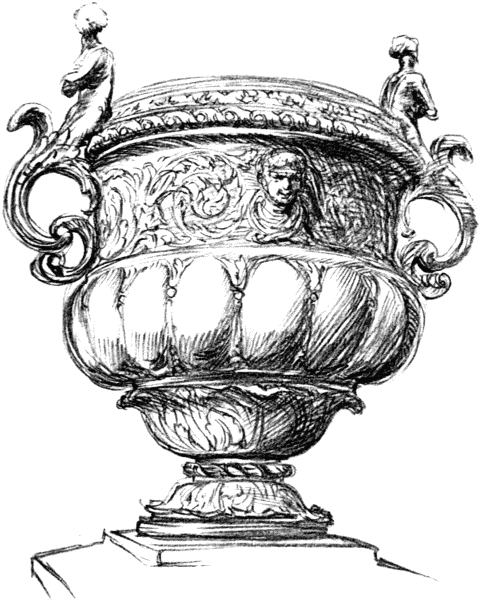
Fig. 47.—Vase, Hampton Court.
[116]
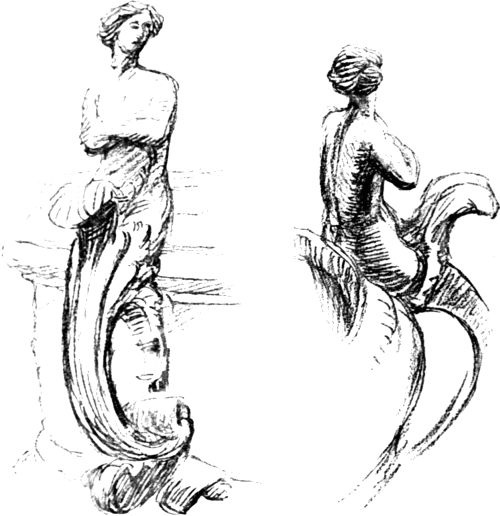
Fig. 48.—From Vase, Hampton Court.
There are several vases at Wimpole near Cambridge, at Wilton, and at Wrest. Little square flower boxes with cast or repoussé devices on the sides were also made; Charles Lamb describes some flower pots for us from the gardens of Blakesware in Herefordshire, a fine old house, destroyed even when he wrote—“The owner of it had lately pulled it down; still I had a vague notion that it could not all have perished.[117] How shall they build it up again?” There was a beautiful fruit garden and “ampler pleasure garden rising backwards from the house in triple terraces, with flower pots now of palest lead save that a spot here and there saved from the elements bespake their pristine state to have been gilt and glittering.”
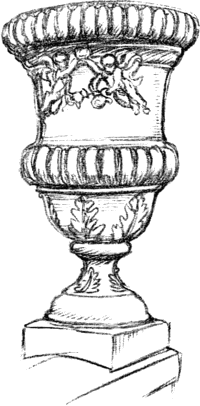
Fig. 49.—Vase, Castle Hill.
At Knole are a pair of circular pots figured on page 120. Circular baskets of open interlacing work and other forms were also made.
[118]
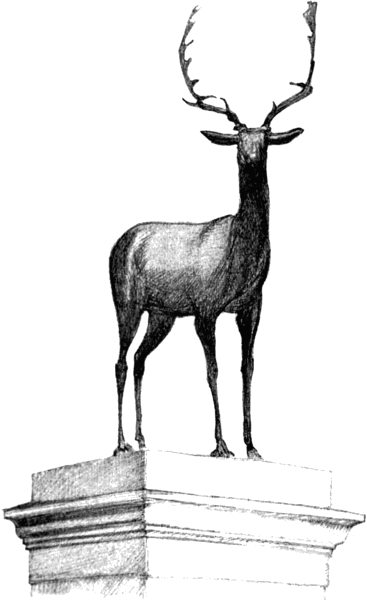
Fig. 50.—Albert Gate.
[119]
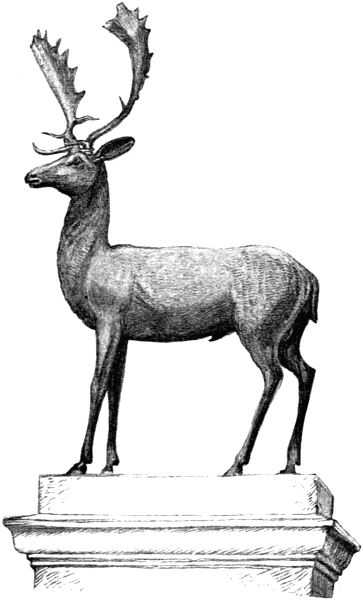
Fig. 51.—Albert Gate.
Garden seats were also made entirely of lead.[120] There are six lead seats at Castle Hill, North Devon; they are large square boxes with heavy “classic” forms, the top and ends imitating the folds of drapery. At Chiswick similar seats in every way were sculptured in stone. These show how lead should not be used.
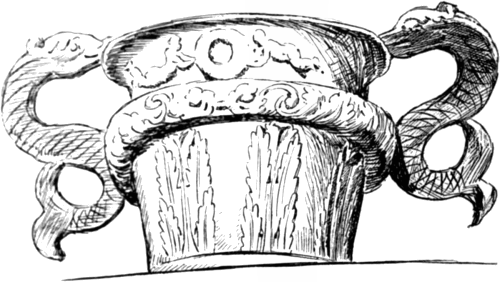
Fig. 52.—Vase on Gate Pier, Knole.
At Castle Hill are also several greyhounds; they are particularly lively and well modelled and suitable for their purpose as guards to the gates. Gate piers are most inviting pedestals for leaden imagery. At Albert Gate, Hyde Park, there are two beautiful lead stags—another pair of them are at Loughton in Essex; no more appropriate English park gate could well be thought of. At Carshalton, Surrey, where a park was enclosed by Thomas Scawen, the great gate pillars of the entrance have large boldly modelled statues of Diana and Actæon, the date 1726. The little Cupids that[121] stand out of the ivy that covers the piers at Temple Dinsley are sketched in Fig. 53.
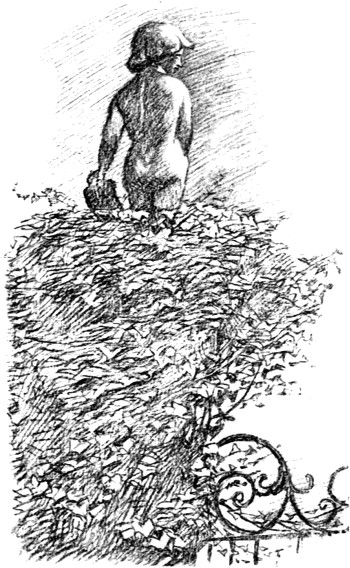
Fig. 53.—Temple Dinsley.
Perhaps the finest gate pier groups are those to the Flower Pot Gate at Hampton Court, where Cupids uphold a basket of flowers. These able pieces of work are not generally known for lead, because, like so many figures and vases,[122] they have been painted and sanded to imitate stone.
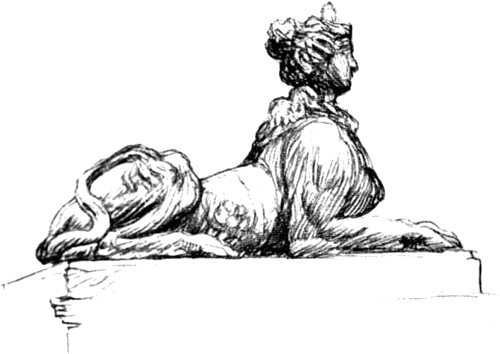
Fig. 54.—Syon House.
In 1744 the then member for Southampton presented two lions for the Bar Gate in that town. These not very beautiful creatures still remain.
Syon House, on the Thames, has besides the great lion, a lesser lion set over Adam’s “lace gateway,” weighing a ton and half, it is unfortunately newly painted and sanded to look like stone, and as the tail sticks out in a way utterly impossible for anything but metal it makes it entirely absurd. There is a plague of paint over old leadwork, which should be gilt or let alone.
[123]
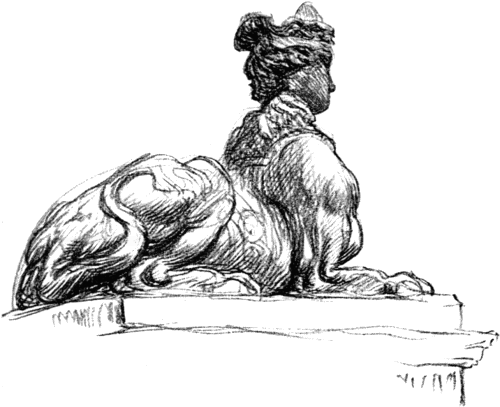
Fig. 55.—Syon House.
On the park wall facing the road there are fine sphinxes, about five feet long, in every way different to the lion, well designed exercises in the “classic taste.” Well modelled, with impressive heads, in the dark and dinted metal, they are pleasant both in colour and texture. They are quite “Adam’s” in character but not at all petty like some of his work and very different to a pair of sphinxes also of lead, on the gates of Chiswick House.
[124]
The lead finial is typically a French feature; there cannot be said to be a single instance of a large ornamental finial of lead remaining in England of the kind once so universal in France and of which so many still remain there. These French finials from the 12th to the 18th centuries have been sufficiently described, especially by M. De la Queriere, who devotes a volume to them and the cresting of ridges; by Viollet-le-Duc; and in De Caumont’s Abcdaire.
Many of these early French Gothic finials of the 12th and 13th centuries were lead statues formed out of repoussé sheet metal and they surmounted the culminating point of the church, at the apex of the chevet; here was often placed an immense angel with great wings turning as vanes in the wind. At Rouen it is the Virgin with the infant Christ which stands over the Lady Chapel; there was formerly on the main apse a giant St. George horsed and spearing the dragon, melted at the Revolution “they say” into bullets. At Clermont Ferrand is the most remarkable composition, a[125] tall pillar on which stands a colossal Virgin facing the sunrise; round the stem spring out great branches of foliage on which sit four figures—King David with the harp and three others with musical instruments—the ridge is ornamented with open work, and a length of similar foliage reaches down the slope of the roof for some feet on either side of the finial where are two other figures, these are full life size, and the whole must be 20 or more feet high.
At Evreux the apse had a St. Michael treading down Satan. The immense St. Michael that surmounted the central tower at Mont St. Michel, which could be seen many leagues out at sea, was also probably of lead.
We had in England in the twelfth century a large figure serving as a finial to the central tower at Canterbury. This tower was built by Lanfranc, and Gervase tells us it was surmounted by a gilt angel, this is shown in the contemporary drawing of Canterbury; and the tower, Professor Willis says, ever retained the name of the Angel Tower. Stow also told us of a lead spire close by St. Paul’s with an image of St. Paul on the top.
[126]

Fig. 56.—Finial at Lille.
The early French examples of finials without a figure were formed of foliage in repoussé on a stem or pillar with swelling bands or bowl-like forms at the point of growth: these and the foliage were beaten out of thick sheet lead, the larger forms in two halves and soldered together.[127] The central stem was an iron rod covered with lead tube slipped over it in short pieces, with hooks to hang the branching leaves to; sometimes slender rods rise out of the foliage and droop with lilies at their extremities.

Fig. 57.—Finial at Angers.
Later, cast ornaments became general; on the Hôtel Dieu at Beaune is a wonderful series of these finials made up of portions partly repoussé partly cast, these have coronets of delicate open work which were cast in strips and bent round. Where the finial joins the roof a rayed sun of cast metal is placed. Mr. Clutton gives drawings of these.
In the Museum at Lille there are two fine finials, one of these is carefully analysed to a large scale by Burges in his book of drawings and the other, wholly made up of castings, is given here from a photograph. In the Museum in the splendid old hall of the Hôtel Dieu at Angers are two, sketches of which are given in Figs. 57 and 58. The leaves and scrolls are cast with ribs to make them stiffer.
The later Gothic and Renaissance finials are often charmingly suggestive in the subject of their design—some have figures, a huntsman at Bourges, a Cupid shooting arrows or a man-at-arms; some are made up with suns or sun and moon, or moon and stars, as at Troyes; at Beaune, cup-like forms are made of openwork for birds’ nests. Again we find a vase of lilies or branch of drooping thistles, a pigeon, a coronet,[128] or personal devices and badges. Mr. Burges noted how the early poets spoke of the music of the vanes, and there can be little doubt that some of them were intended to resound to the wind: in the Hypnerotomachia (1499) a finial is shown with little bells hanging to chains which swang against a metal bowl; Viollet-le-Duc also tells us that in certain crestings he found a singular musical conceit in contrivances for producing “sifflements” under the action of the wind—Æolian flutes.
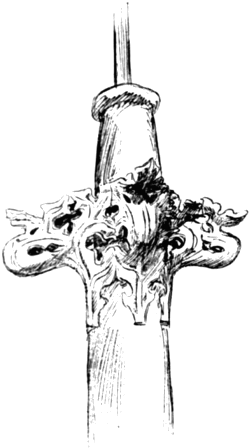
Fig. 58.—Angers.
[129]
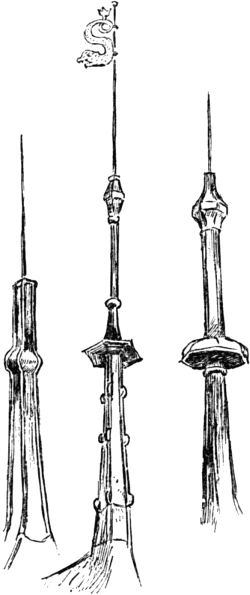
Fig. 59.—Finials, Bourges.
At Bourges on the Hôtels Jacques Cœur and Cujas are some finials consisting of little more than a lead-covered stick bearing a rod and girouettes. Flags were properly only set up in the due heraldic precedence of the proprietor, a Knight might fly a pennon and so on; they were centred at times on a piece of agate to reduce the friction of revolution. We have only to look at[130] the views of old towns given in manuscripts to see how the mediæval mind delighted in these flag finials; but there are probably not half a dozen old ones now left in England. When there are many revolving flags to the finials on one building and these are bright with new gold, they have the delightful property of flashing the light to a great distance. The gilt flags on the pinnacles of the west front of Wells Cathedral twinkle simultaneously against the setting sun.
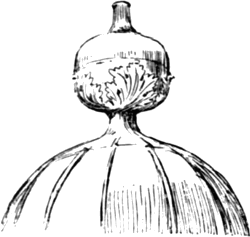
Fig. 60.—From Newcastle.
Crestings, sometimes large and most ornamental, were formed along the ridges of French buildings, especially in the early Renaissance.[30] These ornamental ridges, especially in this exaggerated form, are not English.
A row of fleurs-de-lis exists at Exeter, a portion of which is in the Architectural Museum, Westminster: and probably many other roofs had similar crestings.
[131]
The use of lead pipes for conducting water was introduced into England by the Romans, the ordinary draw-off tap is another gift of theirs. The twelfth century plan of Canterbury cathedral shows a remarkable system of water pipes for collecting the water from the roofs and distributing it to the several buildings and fountains. Mr. Micklethwaite has described in Archæologia a lead filtering cistern with draw-off tap found at Westminster Abbey; and in the British Museum (Gothic Room) there is a small circular lead cistern with delicate fifteenth century ornament.
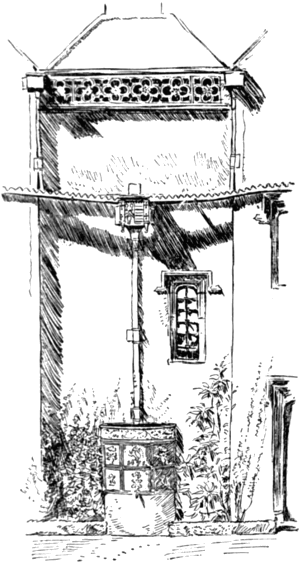
Fig. 61.—Poundisford Park, Taunton.
Some old country houses preserve the original scheme for conducting the rain water from the roofs into a lead cistern which, adorned by devices and gilding, stood close to the front door. Poundisford Park, near Taunton, is one of these. Lead spouting, delicately ornamented, crosses the front and brings the water to the head of the vertical pipe, which has turrets and loopholes—a toy castle. This and its pipe stand over a circular fronted cistern panelled and modelled[132] with a crest, pots of flowers, and the date 1671. There are some of these cisterns at Exeter; one of them, here given, is much like that at Taunton, and is dated 1696; the ribs and devices are gilt.[133] At Bovey Tracy, in Devonshire, there is another, as also at Sackville College, East Grinstead.
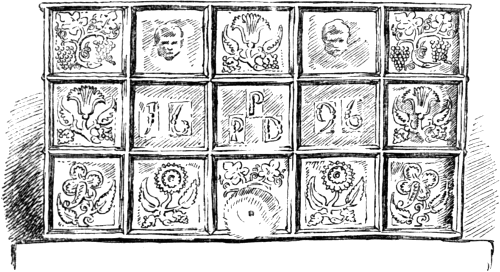
Fig. 62.—Cistern, Exeter.
In the London houses of the seventeenth and eighteenth centuries, ornamented lead cisterns seem to have been generally placed in the courtyards and areas. The earliest known was illustrated and described in the Builder for August 23rd, 1862. The centre was a coat of arms quartering the lions of England and the lilies of France, right and left two quatrefoil panels contained the letters E.R., and below in a long panel was the date 15—. Two upright strips formed the margins, which, with the ends, were covered with Gothic diaper. It was drawn while in the possession of a dealer, who obtained it in Crutched Friars.
There was quite a crusade preached against[134] these cisterns, as the occasion of lead poisoning, in the first half of this century, and hundreds were destroyed, but a large number still remain; about Bloomsbury quite a dozen may be seen down front areas. For the most part they were decorated with panelling of ribs formed of squares and semicircles with strips and spots of cast ornament, flowers, fruit baskets, stags, dolphins, cherubs’ heads, and even the gods Bacchus and Ceres; others have nothing but the fretted panel with initials and date like Fig. 63.
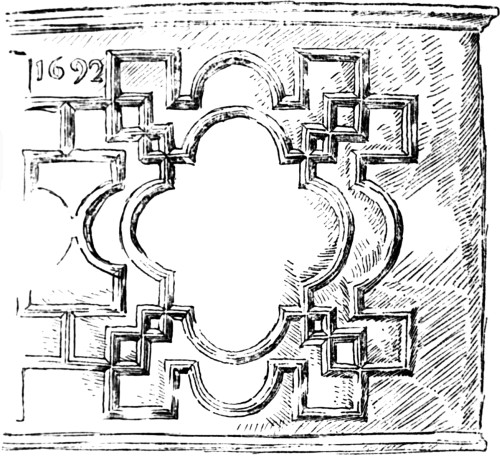
Fig. 63.—Cistern, London.
[135]
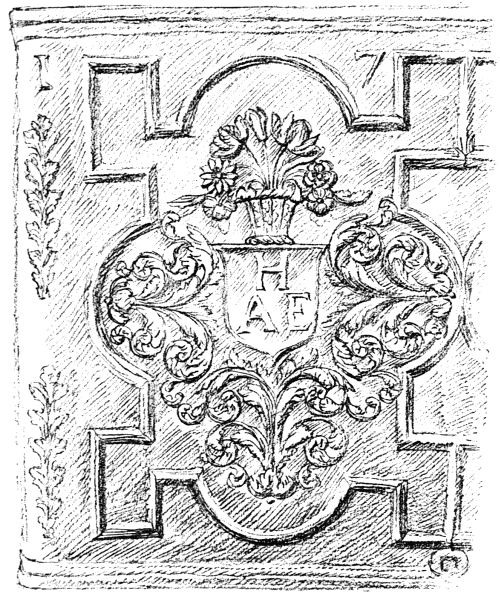
Fig. 64.—Cistern, S. Kensington Museum.
The ribs, with the stock enrichments in new combinations, the date and initials, were attached to a wood panel the size of the cistern front; this was moulded in the sand and the casting[136] made of good substance; stout strips were soldered across the inside as ties. One of the finest known of these is that at South Kensington Museum, of which one half of the front is here illustrated, the other half repeats exactly, even to the initials on the shield; the date is 1732. This is in every way well designed and beautifully modelled. A part of one in the Guildhall Museum is an early example of the ordinary pattern, dated 1674.
The ribs for the pattern were formed in lead—a plumber disdaining the assistance of wood if he could avoid it—by beating strips of lead into an iron swage block, that was cut as a matrix about four inches long; these strips could be easily bent to the curved lines. Plain panelled cisterns like this were made as late as 1840.
Old lead pumps are now very seldom to be found. One remains at Wick, Christchurch, which is 6 inches in diameter, and is decorated by a crest—a boar’s head in a wreath—and the initials “G. B.” as well as the signature “J. Jenkins, Plummer, 1797.”
[137]
In England the gutters of important churches were generally formed behind the stone parapet, but at Lincoln the whole is formed of lead above a carved stone cornice. It is about two feet high and the outside is decorated with foiled circles closer or farther apart with due disregard for precision. In France gutters were often like this made on the top of the stone cornice; irons turned up carry a continuous rod, over which the lead was dressed, and as the outlets were frequent little fall was required.[31]
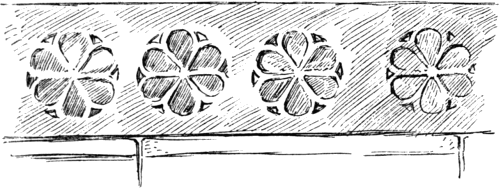
Fig. 65.—Gutter, Lincoln Cathedral.
To some bay windows of a fine old timber[138] house at Derby there are little parapets formed out of lead, the front edge being cut into notches like a tiny battlement, and short lengths of pipe form spouts for the water. At Taunton there is a bay window with a similar battlement of lead; this is cast with a running pattern and wavy upper edge, to this below is soldered a similar strip reversed making a fringe; the same pattern forms the isolated gutters at Poundisford House above mentioned. At Montacute the spouting has a series of little upright panels, the top moulding breaking up higher over every alternate pair in crenelations, leaving a space filled with a boss. At Bramhall there is a cottage to which both the spouting and the down pipe have a running scroll of flowery ornament. Sometimes the end of a roof gutter between two gables is stopped by an apron of lead with pattern on it, such as a knot of cord and initials.

Fig. 66.—Gutter, Taunton.
[139]
The water was discharged from the gutters into the heads of down pipes, or sometimes from jutting lengths of spout supported by iron props, the nozzles cut into a form often simulating an animal’s jaws.
The down pipes are particularly English, nowhere else can the ornate constructions of lead forming the pipe heads of Haddon and other great houses of the sixteenth century be matched. According to Viollet-le-Duc, here in England this arrangement was already in use in the fourteenth century, when nowhere except in England were these lead pipes from the roof down to the base of the wall known. He also remarks on the advantage of these being square as they can expand if required when the water freezes, while a circular pipe can only burst.[32] Fragments of pierced work in Gothic patterns which formed parts of pipe heads have been found at Fountains Abbey.
[140]
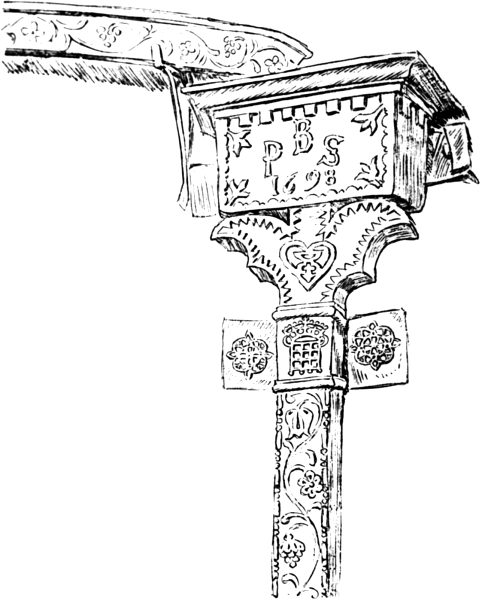
Fig. 67.—Bramhall, Cheshire.
At Haddon there are a great number of these pipe heads of several dates, and every one is different from the rest; some are plain and small, others great spreading things elaborately decorated. The general form of these is constructed like a box from cast sheet lead, the cornices are beaten to their shape over a pattern; and the top edge is cut into a little fringe of crenellations. Cast discs of ornament, badges, pendant knobs, and initials are arranged on their fronts, on the funnel-shaped portion leading to the pipe, and on the ears of the pipe and the side flaps of the head itself. The more elaborate heads have an outer casing of lead with panels pierced through it of delicate tracery work of Gothic tradition which shows bright against the shadow.
[141]
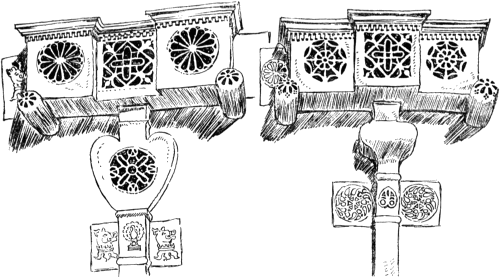
Figs. 68 and 69.—Pipe Heads, Haddon Hall.
[142]
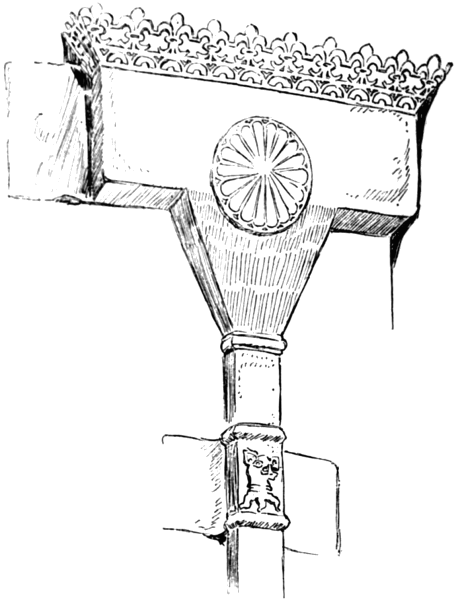
Fig. 70.—Pipe head, Haddon.
[143]
At Windsor Castle some pipe heads bear the date 1589, the Tudor rose, and the letters E. R.
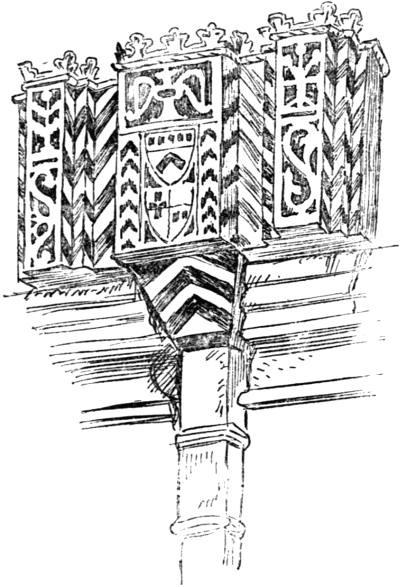
Fig. 71.—Bodleian, Oxford.
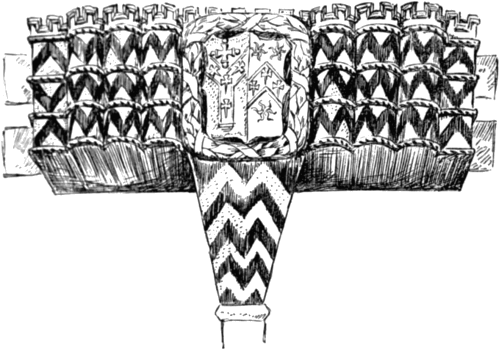
Fig. 72.—St. John’s, Oxford.
At Knole there are also many heads having pierced work of this kind in panels, and projecting turrets; some of these also have a decoration of bright solder applied to the lead in patterns—these[144] were made about 1600. At the Bodleian and St. John’s College, Oxford, there is a fine series of pipe heads with painted patterns. At Norham Castle some pipe heads are dated 1605. Abbot’s Hospital at Guildford has a large series of heads later in character than those at Haddon. Here pierced work is used as a brattishing to the top edge of the fronts; they are signed G. A. and dated 1627. At Canons Ashby there is a pair of most rococo pipe heads, with applied pierced castings, masks and acanthus leaves.[33] These heads are fixed on iron cramps, or brackets; at Haddon[145] lead cylinders with pierced ends project and carry the heads.

Fig. 73.—Sherborne.
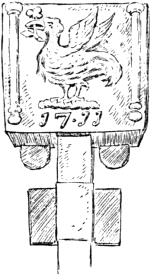
Fig. 74.—Liverpool.
Sometimes the heads are very long, extending five or six feet like a length of gutter; it was a favourite method to decorate them with salient projections at intervals, like the cut-waters of a bridge, the top edge of these is cut into little battlements which were curled over in loops. The projections make convenient birds’ nests. The pipe is sometimes central to these long heads but often at the end.
Entirely the reverse of these, other heads are tall in proportion, like the examples at Shrewsbury and Ludlow or the little fiddle pattern design given here from the Grammar School at Sherborne[146] (Fig. 73). The two examples 74 and 75 are from Liverpool and Ashbourn.
There are three or four original pipe heads which are well designed in the Architectural Museum.
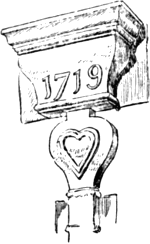
Fig. 75.—Ashbourne.
The later ones, as in London, are often tall square funnels moulded and bent into vase-like forms, the projection was small compared to the width, only three or four inches sometimes. A piece of projecting pipe is at times inserted in the front of the head to serve as an overflow. The late pipes were circular and the heads very often followed this form.
The material has an appropriateness for this purpose that cast iron cannot pretend to; a simple square box of lead and round pipe is much to be preferred to fussy things in cast iron, they will not require painting, nor do they fill the drains[147] with rust; and although it has been necessary to draw the elaborate and eccentric forms, the simpler ones form better models for our purpose.
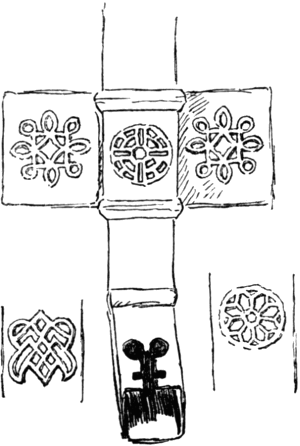
Fig. 76.—Haddon.
The earlier pipes were almost always a flat square, sometimes ornamented up its whole length, but usually only at the collars, where the bands of lead for attachment to the wall were placed, here and on the flaps of the collars are often crests, flowers, or letters. The lead band was cut long enough, so that after the nails had been driven through it into the wall the ends were folded back over their heads. Those at Canons Ashby, Northants, have the ends curled and cut like the scroll of a mediæval text.
[148]
Lead working as an art for the expression of beauty through material, with this ancestry of nearly two thousand years of beautiful workmanship behind it here in England, has in the present century been entirely killed out. Only one simple present use of lead can be mentioned as having the characteristic of an art—the expression of personal thought by the worker to give pleasure. This is nothing but the lining of stairs and floor spaces with sheet lead nailed with rows of copper nails, some examples of which are done with a certain taste. Pipe heads and other objects of a somewhat ornamental kind have recently been made again, but we must remember that ornament is not art, and these have only been carefully, painfully, “executed” to the architect’s drawings. The plumber’s art, as it was, for instance, when the Guild of Plumbers was formed, a craft to be graced by the free fancy of the worker, is a field untilled. That someone may again take up this fine old craft of lead-working as an artist and original worker, refusing to follow “designs” compiled by another from imperfectly understood old examples, but expressing only himself—this has been my chief hope in preparing the little book NOW CONCLUDED.
[1]
DRAWING AND DESIGN. A Class Text-book for Beginners. By E. R. Taylor. Head Master of the Birmingham Municipal School of Art. With Illustrations. Oblong crown 8vo, 5s. net.
ELEMENTS OF HANDICRAFT AND DESIGN. By W. A. S. Benson, M.A. Oxon. With Illustrations. Extra crown 8vo, 5s. net.
A TEXT-BOOK OF NEEDLEWORK, KNITTING AND CUTTING-OUT. With Methods of Teaching. By Miss Elizabeth Rosevear, Senior Teacher, and Lecturer on Needlework, Training College, Stockwell, London. With Original Illustrations and Sectional Diagrams. Crown 8vo, 6s.
SATURDAY REVIEW.—“A very useful book of reference for teachers of elementary sewing classes.”
SCHOOLMASTER.—“This is a remarkably clever and practical text-book on Needlework.”
QUEEN.—“It has been carefully prepared by an intellectual teacher, expert in the art of demonstration lessons, and anxious to impart to others the results of her experience as Senior Teacher and Lecturer at Stockwell Training College.”
A PRIMER OF DOMESTIC ECONOMY. By Edith A. Barnett and H. C. O’Neill. Pott 8vo, 1s.
SCOTSMAN.—“It is in its way unique among school books, touching the fringe of a great variety of subjects—hygiene, economics, physiology, cooking, medicine, and the sciences dealing with money. Of these it says a little that every housekeeper ought to know, and opens the way for more. It is an admirable school book.”
SATURDAY REVIEW.—“A capital little book for the young householder.”
A PRIMER OF PRACTICAL HORTICULTURE. Ten Lectures delivered for the Surrey County Council, by J. Wright, F.R.H.S. (Horticultural Instructor), Assistant Editor of the “Journal of Horticulture,” Editor of “Garden Work.” With 37 Illustrations. Pott 8vo, 1s.
SPECTATOR.—“A most useful little book, giving hints on various profitable kinds of cultivation. The contents were originally given as lectures, and it is an excellent idea to have them re-published.”
THE FOOD OF PLANTS. By A. P. Laurie, M.A., Fellow of King’s College, Cambridge. Adviser in Technical Education to the Bedfordshire County Council. Pott 8vo, 1s.
NATURE.—“This little book is intended to be an introduction to agriculture. The experiments are carefully chosen and described and can be performed with inexpensive materials, and the book, especially if used as the author suggests, in conjunction with a Chemistry Primer, can well be recommended as an interesting guide to the study of agriculture.”
A MANUAL OF DAIRY WORK. By Professor James Muir, of the Yorkshire College, Leeds. Pott 8vo, 1s.
SCHOOL BOARD CHRONICLE.—“A very useful and authoritative handbook.... A happy combination of scientific and of practical facts, explanations, and advice.”
THE GRAMMAR OF WOODWORK. A Graduated System of Manual Training for Elementary, Secondary, and Technical Schools, designed for the Pupils of the Whitechapel Craft-School by Walter E. Degerdon, Head Instructor in Woodwork at the Whitechapel Craft-School, formerly Woodwork Instructor in the Cambridge University Engineering Workshops. With a Preface by H. Llewellyn Smith. 4to, Paper Covers, 2s.
SCHOOLMASTER.—“The order of work is clearly mapped out, and the book will be found to be most useful for reference at the bench. We warmly recommend it to the notice of all manual instructors.”
[2]
INTRODUCTORY.
ASTRONOMY.
PHYSICS.
CHEMISTRY.
GEOLOGY.
PHYSICAL GEOGRAPHY.
BOTANY.
PHYSIOLOGY.
LOGIC.
POLITICAL ECONOMY.
Uniform with the Above.
FIRST LESSONS IN PRACTICAL BOTANY.
FIRST PRINCIPLES OF AGRICULTURE.
[3]
ALGEBRA FOR BEGINNERS. By H. S. Hall, M.A., and S. R. Knight, B.A. 2s. With Answers. 2s. 6d.
MECHANICS FOR BEGINNERS. By Rev. J. B. Lock, M.A. Part I. Mechanics of Solids. 2s. 6d.
SCHOOLMASTER.—“Bears the stamp of an author who is thoroughly at home in his subject. Careful arrangement, logical explanation, suitable illustrations and numerous examples testify to the value of the book.”
Part II. Mechanics of Fluids. In preparation.
ELEMENTARY LESSONS IN HEAT, LIGHT, AND SOUND. By Prof. D. E. Jones, B.Sc. 2s. 6d. Adapted to the Elementary Stage of the South Kensington Syllabus.
The questions at the ends of chapters are taken partly from the Elementary Papers of the Science and Art Department.
ELECTRICITY AND MAGNETISM FOR BEGINNERS. Adapted to the Elementary Stage of the South Kensington Syllabus. By Prof. S. P. Thompson. In preparation.
INORGANIC CHEMISTRY FOR BEGINNERS. By Sir Henry Roscoe, F.R.S., assisted by Joseph Lunt, B.Sc. 2s. 6d. Adapted to the Elementary Stage of the South Kensington Syllabus.
ORGANIC CHEMISTRY FOR BEGINNERS. By G. S. Turpin, M.A. Adapted to the Elementary Stage of the South Kensington Syllabus. Ready shortly.
PHYSIOGRAPHY FOR BEGINNERS. By J. E. Marr, M.A., F.R.S., and A. Harker, M.A., F.G.S. Adapted to the Elementary Stage of the South Kensington Syllabus. Ready shortly.
PHYSIOLOGY FOR BEGINNERS. By Prof. Michael Foster and Dr. L. E. Shore. Adapted to the Elementary Stage of the South Kensington Syllabus. Ready shortly.
[4]
Crown 8vo. Cloth.
SEEING AND THINKING.
POPULAR LECTURES AND ADDRESSES.
MODERN VIEWS OF ELECTRICITY.
A CENTURY OF ELECTRICITY.
CHARLES DARWIN.
THE SCIENTIFIC EVIDENCES OF ORGANIC EVOLUTION.
ARE THE EFFECTS OF USE AND DISUSE INHERITED? An Examination of the View held by Spencer and Darwin.
ON THE COLOURS OF FLOWERS.
THE APODIDÆ: A MORPHOLOGICAL STUDY.
SCOTSMAN.—“A book which zoologists will very greatly prize. The writer has worked out the task he set before him with the greatest care and in the most elaborate manner, and has presented the fruits of his labour in a volume which every lover of scientific investigation will thoroughly appreciate.... A valuable contribution to zoological investigation.”
THE RIGHT HAND: LEFT-HANDEDNESS.
MACMILLAN AND CO., LONDON.
Transcriber’s Note:
Missing periods and dashes have been supplied where obviously required. All other original errors and inconsistencies have been retained (of particular note is the ‘v’ for ‘u’ substitution in ‘ILLVSTRATIONS’ on the title page), except as follows (the first line is the original text, the second the passage as currently stands):
End of the Project Gutenberg EBook of Leadwork, by W. R. Lethaby
*** END OF THIS PROJECT GUTENBERG EBOOK LEADWORK ***
***** This file should be named 41544-h.htm or 41544-h.zip *****
This and all associated files of various formats will be found in:
http://www.gutenberg.org/4/1/5/4/41544/
Produced by Chris Curnow, Rosanna Murphy and the Online
Distributed Proofreading Team at http://www.pgdp.net (This
file was produced from images generously made available
by The Internet Archive)
Updated editions will replace the previous one--the old editions
will be renamed.
Creating the works from public domain print editions means that no
one owns a United States copyright in these works, so the Foundation
(and you!) can copy and distribute it in the United States without
permission and without paying copyright royalties. Special rules,
set forth in the General Terms of Use part of this license, apply to
copying and distributing Project Gutenberg-tm electronic works to
protect the PROJECT GUTENBERG-tm concept and trademark. Project
Gutenberg is a registered trademark, and may not be used if you
charge for the eBooks, unless you receive specific permission. If you
do not charge anything for copies of this eBook, complying with the
rules is very easy. You may use this eBook for nearly any purpose
such as creation of derivative works, reports, performances and
research. They may be modified and printed and given away--you may do
practically ANYTHING with public domain eBooks. Redistribution is
subject to the trademark license, especially commercial
redistribution.
*** START: FULL LICENSE ***
THE FULL PROJECT GUTENBERG LICENSE
PLEASE READ THIS BEFORE YOU DISTRIBUTE OR USE THIS WORK
To protect the Project Gutenberg-tm mission of promoting the free
distribution of electronic works, by using or distributing this work
(or any other work associated in any way with the phrase "Project
Gutenberg"), you agree to comply with all the terms of the Full Project
Gutenberg-tm License available with this file or online at
www.gutenberg.org/license.
Section 1. General Terms of Use and Redistributing Project Gutenberg-tm
electronic works
1.A. By reading or using any part of this Project Gutenberg-tm
electronic work, you indicate that you have read, understand, agree to
and accept all the terms of this license and intellectual property
(trademark/copyright) agreement. If you do not agree to abide by all
the terms of this agreement, you must cease using and return or destroy
all copies of Project Gutenberg-tm electronic works in your possession.
If you paid a fee for obtaining a copy of or access to a Project
Gutenberg-tm electronic work and you do not agree to be bound by the
terms of this agreement, you may obtain a refund from the person or
entity to whom you paid the fee as set forth in paragraph 1.E.8.
1.B. "Project Gutenberg" is a registered trademark. It may only be
used on or associated in any way with an electronic work by people who
agree to be bound by the terms of this agreement. There are a few
things that you can do with most Project Gutenberg-tm electronic works
even without complying with the full terms of this agreement. See
paragraph 1.C below. There are a lot of things you can do with Project
Gutenberg-tm electronic works if you follow the terms of this agreement
and help preserve free future access to Project Gutenberg-tm electronic
works. See paragraph 1.E below.
1.C. The Project Gutenberg Literary Archive Foundation ("the Foundation"
or PGLAF), owns a compilation copyright in the collection of Project
Gutenberg-tm electronic works. Nearly all the individual works in the
collection are in the public domain in the United States. If an
individual work is in the public domain in the United States and you are
located in the United States, we do not claim a right to prevent you from
copying, distributing, performing, displaying or creating derivative
works based on the work as long as all references to Project Gutenberg
are removed. Of course, we hope that you will support the Project
Gutenberg-tm mission of promoting free access to electronic works by
freely sharing Project Gutenberg-tm works in compliance with the terms of
this agreement for keeping the Project Gutenberg-tm name associated with
the work. You can easily comply with the terms of this agreement by
keeping this work in the same format with its attached full Project
Gutenberg-tm License when you share it without charge with others.
1.D. The copyright laws of the place where you are located also govern
what you can do with this work. Copyright laws in most countries are in
a constant state of change. If you are outside the United States, check
the laws of your country in addition to the terms of this agreement
before downloading, copying, displaying, performing, distributing or
creating derivative works based on this work or any other Project
Gutenberg-tm work. The Foundation makes no representations concerning
the copyright status of any work in any country outside the United
States.
1.E. Unless you have removed all references to Project Gutenberg:
1.E.1. The following sentence, with active links to, or other immediate
access to, the full Project Gutenberg-tm License must appear prominently
whenever any copy of a Project Gutenberg-tm work (any work on which the
phrase "Project Gutenberg" appears, or with which the phrase "Project
Gutenberg" is associated) is accessed, displayed, performed, viewed,
copied or distributed:
This eBook is for the use of anyone anywhere at no cost and with
almost no restrictions whatsoever. You may copy it, give it away or
re-use it under the terms of the Project Gutenberg License included
with this eBook or online at www.gutenberg.org
1.E.2. If an individual Project Gutenberg-tm electronic work is derived
from the public domain (does not contain a notice indicating that it is
posted with permission of the copyright holder), the work can be copied
and distributed to anyone in the United States without paying any fees
or charges. If you are redistributing or providing access to a work
with the phrase "Project Gutenberg" associated with or appearing on the
work, you must comply either with the requirements of paragraphs 1.E.1
through 1.E.7 or obtain permission for the use of the work and the
Project Gutenberg-tm trademark as set forth in paragraphs 1.E.8 or
1.E.9.
1.E.3. If an individual Project Gutenberg-tm electronic work is posted
with the permission of the copyright holder, your use and distribution
must comply with both paragraphs 1.E.1 through 1.E.7 and any additional
terms imposed by the copyright holder. Additional terms will be linked
to the Project Gutenberg-tm License for all works posted with the
permission of the copyright holder found at the beginning of this work.
1.E.4. Do not unlink or detach or remove the full Project Gutenberg-tm
License terms from this work, or any files containing a part of this
work or any other work associated with Project Gutenberg-tm.
1.E.5. Do not copy, display, perform, distribute or redistribute this
electronic work, or any part of this electronic work, without
prominently displaying the sentence set forth in paragraph 1.E.1 with
active links or immediate access to the full terms of the Project
Gutenberg-tm License.
1.E.6. You may convert to and distribute this work in any binary,
compressed, marked up, nonproprietary or proprietary form, including any
word processing or hypertext form. However, if you provide access to or
distribute copies of a Project Gutenberg-tm work in a format other than
"Plain Vanilla ASCII" or other format used in the official version
posted on the official Project Gutenberg-tm web site (www.gutenberg.org),
you must, at no additional cost, fee or expense to the user, provide a
copy, a means of exporting a copy, or a means of obtaining a copy upon
request, of the work in its original "Plain Vanilla ASCII" or other
form. Any alternate format must include the full Project Gutenberg-tm
License as specified in paragraph 1.E.1.
1.E.7. Do not charge a fee for access to, viewing, displaying,
performing, copying or distributing any Project Gutenberg-tm works
unless you comply with paragraph 1.E.8 or 1.E.9.
1.E.8. You may charge a reasonable fee for copies of or providing
access to or distributing Project Gutenberg-tm electronic works provided
that
- You pay a royalty fee of 20% of the gross profits you derive from
the use of Project Gutenberg-tm works calculated using the method
you already use to calculate your applicable taxes. The fee is
owed to the owner of the Project Gutenberg-tm trademark, but he
has agreed to donate royalties under this paragraph to the
Project Gutenberg Literary Archive Foundation. Royalty payments
must be paid within 60 days following each date on which you
prepare (or are legally required to prepare) your periodic tax
returns. Royalty payments should be clearly marked as such and
sent to the Project Gutenberg Literary Archive Foundation at the
address specified in Section 4, "Information about donations to
the Project Gutenberg Literary Archive Foundation."
- You provide a full refund of any money paid by a user who notifies
you in writing (or by e-mail) within 30 days of receipt that s/he
does not agree to the terms of the full Project Gutenberg-tm
License. You must require such a user to return or
destroy all copies of the works possessed in a physical medium
and discontinue all use of and all access to other copies of
Project Gutenberg-tm works.
- You provide, in accordance with paragraph 1.F.3, a full refund of any
money paid for a work or a replacement copy, if a defect in the
electronic work is discovered and reported to you within 90 days
of receipt of the work.
- You comply with all other terms of this agreement for free
distribution of Project Gutenberg-tm works.
1.E.9. If you wish to charge a fee or distribute a Project Gutenberg-tm
electronic work or group of works on different terms than are set
forth in this agreement, you must obtain permission in writing from
both the Project Gutenberg Literary Archive Foundation and Michael
Hart, the owner of the Project Gutenberg-tm trademark. Contact the
Foundation as set forth in Section 3 below.
1.F.
1.F.1. Project Gutenberg volunteers and employees expend considerable
effort to identify, do copyright research on, transcribe and proofread
public domain works in creating the Project Gutenberg-tm
collection. Despite these efforts, Project Gutenberg-tm electronic
works, and the medium on which they may be stored, may contain
"Defects," such as, but not limited to, incomplete, inaccurate or
corrupt data, transcription errors, a copyright or other intellectual
property infringement, a defective or damaged disk or other medium, a
computer virus, or computer codes that damage or cannot be read by
your equipment.
1.F.2. LIMITED WARRANTY, DISCLAIMER OF DAMAGES - Except for the "Right
of Replacement or Refund" described in paragraph 1.F.3, the Project
Gutenberg Literary Archive Foundation, the owner of the Project
Gutenberg-tm trademark, and any other party distributing a Project
Gutenberg-tm electronic work under this agreement, disclaim all
liability to you for damages, costs and expenses, including legal
fees. YOU AGREE THAT YOU HAVE NO REMEDIES FOR NEGLIGENCE, STRICT
LIABILITY, BREACH OF WARRANTY OR BREACH OF CONTRACT EXCEPT THOSE
PROVIDED IN PARAGRAPH 1.F.3. YOU AGREE THAT THE FOUNDATION, THE
TRADEMARK OWNER, AND ANY DISTRIBUTOR UNDER THIS AGREEMENT WILL NOT BE
LIABLE TO YOU FOR ACTUAL, DIRECT, INDIRECT, CONSEQUENTIAL, PUNITIVE OR
INCIDENTAL DAMAGES EVEN IF YOU GIVE NOTICE OF THE POSSIBILITY OF SUCH
DAMAGE.
1.F.3. LIMITED RIGHT OF REPLACEMENT OR REFUND - If you discover a
defect in this electronic work within 90 days of receiving it, you can
receive a refund of the money (if any) you paid for it by sending a
written explanation to the person you received the work from. If you
received the work on a physical medium, you must return the medium with
your written explanation. The person or entity that provided you with
the defective work may elect to provide a replacement copy in lieu of a
refund. If you received the work electronically, the person or entity
providing it to you may choose to give you a second opportunity to
receive the work electronically in lieu of a refund. If the second copy
is also defective, you may demand a refund in writing without further
opportunities to fix the problem.
1.F.4. Except for the limited right of replacement or refund set forth
in paragraph 1.F.3, this work is provided to you 'AS-IS', WITH NO OTHER
WARRANTIES OF ANY KIND, EXPRESS OR IMPLIED, INCLUDING BUT NOT LIMITED TO
WARRANTIES OF MERCHANTABILITY OR FITNESS FOR ANY PURPOSE.
1.F.5. Some states do not allow disclaimers of certain implied
warranties or the exclusion or limitation of certain types of damages.
If any disclaimer or limitation set forth in this agreement violates the
law of the state applicable to this agreement, the agreement shall be
interpreted to make the maximum disclaimer or limitation permitted by
the applicable state law. The invalidity or unenforceability of any
provision of this agreement shall not void the remaining provisions.
1.F.6. INDEMNITY - You agree to indemnify and hold the Foundation, the
trademark owner, any agent or employee of the Foundation, anyone
providing copies of Project Gutenberg-tm electronic works in accordance
with this agreement, and any volunteers associated with the production,
promotion and distribution of Project Gutenberg-tm electronic works,
harmless from all liability, costs and expenses, including legal fees,
that arise directly or indirectly from any of the following which you do
or cause to occur: (a) distribution of this or any Project Gutenberg-tm
work, (b) alteration, modification, or additions or deletions to any
Project Gutenberg-tm work, and (c) any Defect you cause.
Section 2. Information about the Mission of Project Gutenberg-tm
Project Gutenberg-tm is synonymous with the free distribution of
electronic works in formats readable by the widest variety of computers
including obsolete, old, middle-aged and new computers. It exists
because of the efforts of hundreds of volunteers and donations from
people in all walks of life.
Volunteers and financial support to provide volunteers with the
assistance they need are critical to reaching Project Gutenberg-tm's
goals and ensuring that the Project Gutenberg-tm collection will
remain freely available for generations to come. In 2001, the Project
Gutenberg Literary Archive Foundation was created to provide a secure
and permanent future for Project Gutenberg-tm and future generations.
To learn more about the Project Gutenberg Literary Archive Foundation
and how your efforts and donations can help, see Sections 3 and 4
and the Foundation information page at www.gutenberg.org
Section 3. Information about the Project Gutenberg Literary Archive
Foundation
The Project Gutenberg Literary Archive Foundation is a non profit
501(c)(3) educational corporation organized under the laws of the
state of Mississippi and granted tax exempt status by the Internal
Revenue Service. The Foundation's EIN or federal tax identification
number is 64-6221541. Contributions to the Project Gutenberg
Literary Archive Foundation are tax deductible to the full extent
permitted by U.S. federal laws and your state's laws.
The Foundation's principal office is located at 4557 Melan Dr. S.
Fairbanks, AK, 99712., but its volunteers and employees are scattered
throughout numerous locations. Its business office is located at 809
North 1500 West, Salt Lake City, UT 84116, (801) 596-1887. Email
contact links and up to date contact information can be found at the
Foundation's web site and official page at www.gutenberg.org/contact
For additional contact information:
Dr. Gregory B. Newby
Chief Executive and Director
gbnewby@pglaf.org
Section 4. Information about Donations to the Project Gutenberg
Literary Archive Foundation
Project Gutenberg-tm depends upon and cannot survive without wide
spread public support and donations to carry out its mission of
increasing the number of public domain and licensed works that can be
freely distributed in machine readable form accessible by the widest
array of equipment including outdated equipment. Many small donations
($1 to $5,000) are particularly important to maintaining tax exempt
status with the IRS.
The Foundation is committed to complying with the laws regulating
charities and charitable donations in all 50 states of the United
States. Compliance requirements are not uniform and it takes a
considerable effort, much paperwork and many fees to meet and keep up
with these requirements. We do not solicit donations in locations
where we have not received written confirmation of compliance. To
SEND DONATIONS or determine the status of compliance for any
particular state visit www.gutenberg.org/donate
While we cannot and do not solicit contributions from states where we
have not met the solicitation requirements, we know of no prohibition
against accepting unsolicited donations from donors in such states who
approach us with offers to donate.
International donations are gratefully accepted, but we cannot make
any statements concerning tax treatment of donations received from
outside the United States. U.S. laws alone swamp our small staff.
Please check the Project Gutenberg Web pages for current donation
methods and addresses. Donations are accepted in a number of other
ways including checks, online payments and credit card donations.
To donate, please visit: www.gutenberg.org/donate
Section 5. General Information About Project Gutenberg-tm electronic
works.
Professor Michael S. Hart was the originator of the Project Gutenberg-tm
concept of a library of electronic works that could be freely shared
with anyone. For forty years, he produced and distributed Project
Gutenberg-tm eBooks with only a loose network of volunteer support.
Project Gutenberg-tm eBooks are often created from several printed
editions, all of which are confirmed as Public Domain in the U.S.
unless a copyright notice is included. Thus, we do not necessarily
keep eBooks in compliance with any particular paper edition.
Most people start at our Web site which has the main PG search facility:
www.gutenberg.org
This Web site includes information about Project Gutenberg-tm,
including how to make donations to the Project Gutenberg Literary
Archive Foundation, how to help produce our new eBooks, and how to
subscribe to our email newsletter to hear about new eBooks.